
IN SEASON 2023 e v POLLINATORS’ PURPOSE • FAMILY+FRIENDS+FOOD • A PIEROGI PRIMER
the Taylors’
ZONES consider bees’ needs NO. 49 IN SEASON 2023 OUR FOOD, OUR STORIES, OUR COMMUNITY MEMBER OF EDIBLE COMMUNITIES 49
MILKWEED FARM, the little farm that could FAMILY, FRIENDS, AND FOOD at
Outermost Inn POLLINATION

ARCHITECTURE. BUILDING. INTERIORS. SOLAR. SOUTHMOUNTAIN.COM think outside the house
LIGHTHOUSE ROAD, AQUINNAH



Waterview beach house in Aquinnah just a hop skip and a jump to the calm and sandy waters of the North Shore. Traditional layout with the kitchen, living, dining room and full bath on the first floor. The living room comes with water views and a cozy fireplace, and multiple sliding doors that walk out to the wrap around porch. Upstairs the views are increasingly beautiful! Four bedrooms share a full bath, one of the bedrooms has a fireplace while two have sliding doors that walk out to water view balconies. The full walkout basement/garage offers plenty of room for a vehicle, extra storage or to set up a ping pong table. This bright and airy home is the perfect Aquinnah retreat. Exclusively offered please inquire.



508.645.2628 Chilmark
508.696.9999 West Tisbury
Specializing in Choice Properties Since 1967 504 State Road, West Tisbury MA 02575 · Beetlebung Corner, Chilmark MA 02535 www.tealaneassociates.com
Chef Richard Doucette utilizes his passion, creativity and training to create dining experiences that exceed all expectations. He consistently pushes the boundaries of imagination to compose sophisticated yet approachable flavors with a modern twist


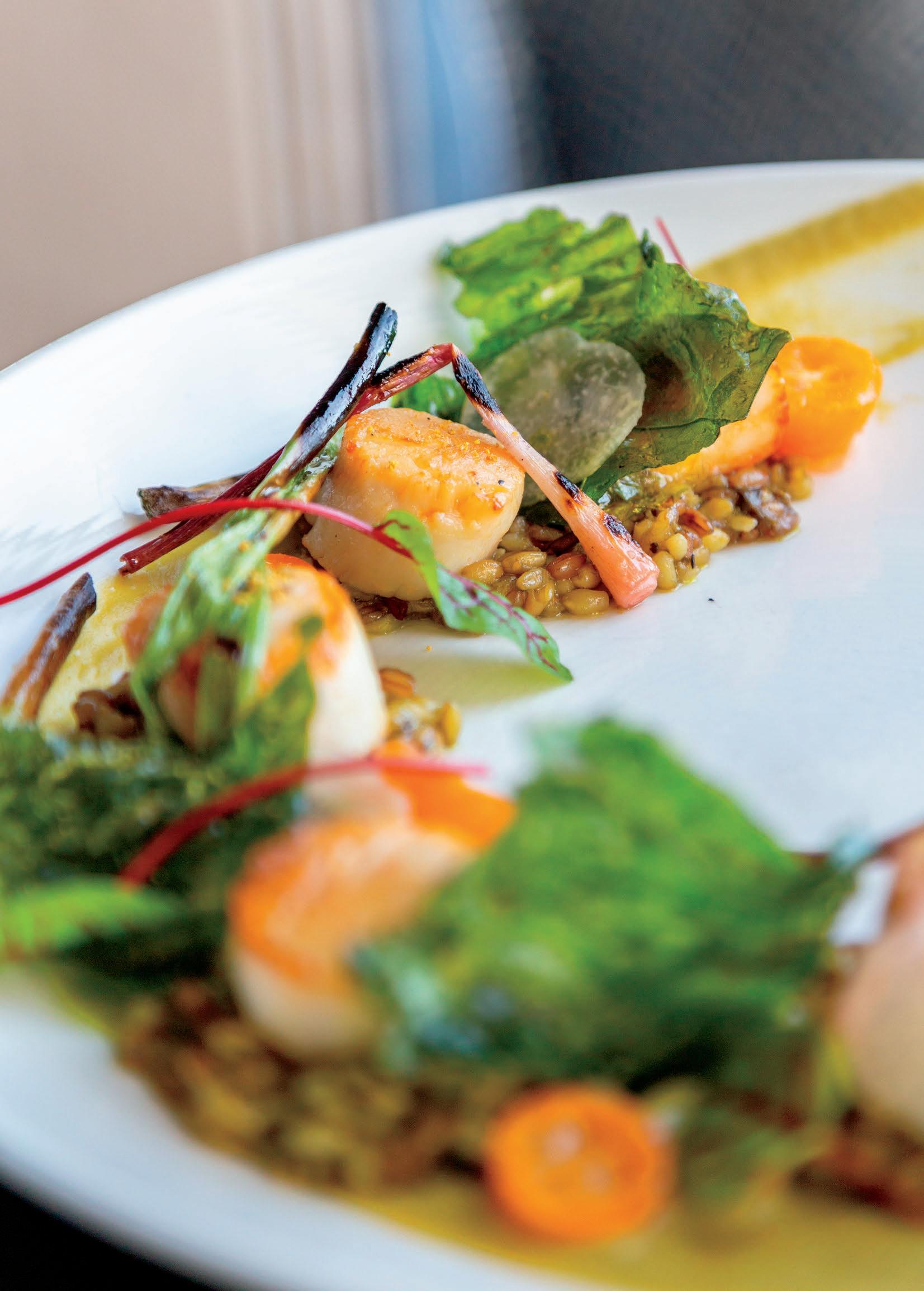

His scratch kitchen cooking approach consists of elegant dishes that showcase his relationships with local farms, harvesters and fisheries
A P P R O A C H scratch
K I T C H E N C O O K I N G
Q U A L I T Y , P A S S I O N , C R E A T I V I T Y
C h e f R i c h a r d a n d h i s t e a m p a r t n e r w i t h
l o c a l m a r k e t s a n d f a r m s t o c r e a t e a
m e n u o f c r e a t i v e , c o a s t a l c u i s i n e
s o u r c e d f r o m t h e f r e s h e s t i n g r e d i e n t s .
C h e f h a n d m a k e s a l l o f t h e s a u c e s ,
b r e a d s , p a s t a , b u t t e r a n d i c e c r e a m
y o u ' l l f i n d o n o u r m e n u s .
F A R M T O T A B L E O Y S T E R S P E C I A L
L o c a l l y s o u r c e d , j u s t o n e m i l e f r o m t h e
W i n n e t u i n K a t a m a B a y , C h e f s e r v e s u p
o y s t e r s t h r e e w a y s - r a w , d r e s s e d o r
b r o i l e d . H a r v e s t e d a n d s e r v e d t h e s a m e
d a y f o r g u a r a n t e e d f r e s h n e s s .
V I S I T U S
W e i n v i t e y o u t o e n j o y C h e f R i c h a r d ’ s
c u i s i n e , s e r v e d d a i l y i n o u r o c e a n s i d e
d i n i n g r o o m . V i s i t u s v i a o u r 2 5 - m i n u t e
s u n s e t w a t e r c r u i s e t h a t d e p a r t s
d o w n t o w n E dg a r t o w n d a i l y a t 5 : 3 0 P M o r
b y c a r - p a r k i n g i s a l w a y s f r e e !
2 edible VINEYARD
E X E C U T I V E C H E F M E E T C H E
RICHARD DOUCETTE
F
T H E D U N E S M V C O M | 5 0 8 6 2 7 3 6 6 3 3 1 D U N E S R O A D , E D G A R T O W N
PUBLISHERS
Peter and Barbara Oberfest
EDITORS
Tina Miller and Connie Berry tina@mvtimes.com • connie@mvtimes.com
CREATIVE DIRECTOR
Kristófer Rabasca
PRODUCTION/DESIGN MANAGER
Dave Plath
DESIGN
Nicole Jackson
PROOFREADER
Irene Ziebarth
AD SALES
Jenna Lambert • jenna@mvtimes.com
Sharisse Scott-Rawlins • sharisse@mvtimes.com
EDIBLE VINEYARD MAGAZINE is published by The Martha’s Vineyard Times, publishers of The Martha’s Vineyard Times weekly newspaper, Vineyard Visitor, Martha’s Vineyard Arts & Ideas Magazine, The Minute daily newsletter, and the websites MVTimes.com, VineyardVisitor.com, and MVArtsandIdeas.com.
You can see the digital version of this magazine at ediblevineyard.com. EV is available at newsstands and select retail locations, free of charge. Find Edible Vineyard on Instagram and Facebook @ediblevineyard
SUBSCRIBE
Please inquire at ediblevineyard@mvtimes.com about subscriptions by mail.

Contact EDIBLE VINEYARD


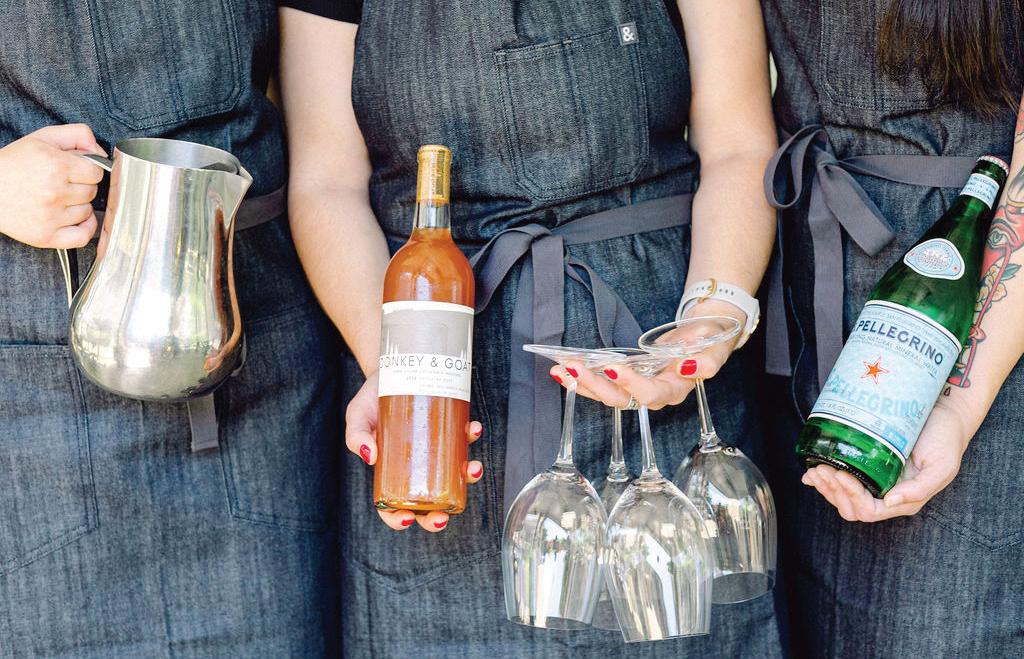
THE MARTHA’S VINEYARD TIMES
P.O. Box 518, 30 Beach Rd. Vineyard Haven, MA 02568 508-693-6100


in season 2023 3
OPEN YEAR ROUND | 63 CIRCUT AVE. OAK BLUFFS, MA | 508-696-0200 | sweetlifemv.com


DISHING
8 Out & About Fresh culinary news from awound the Island.
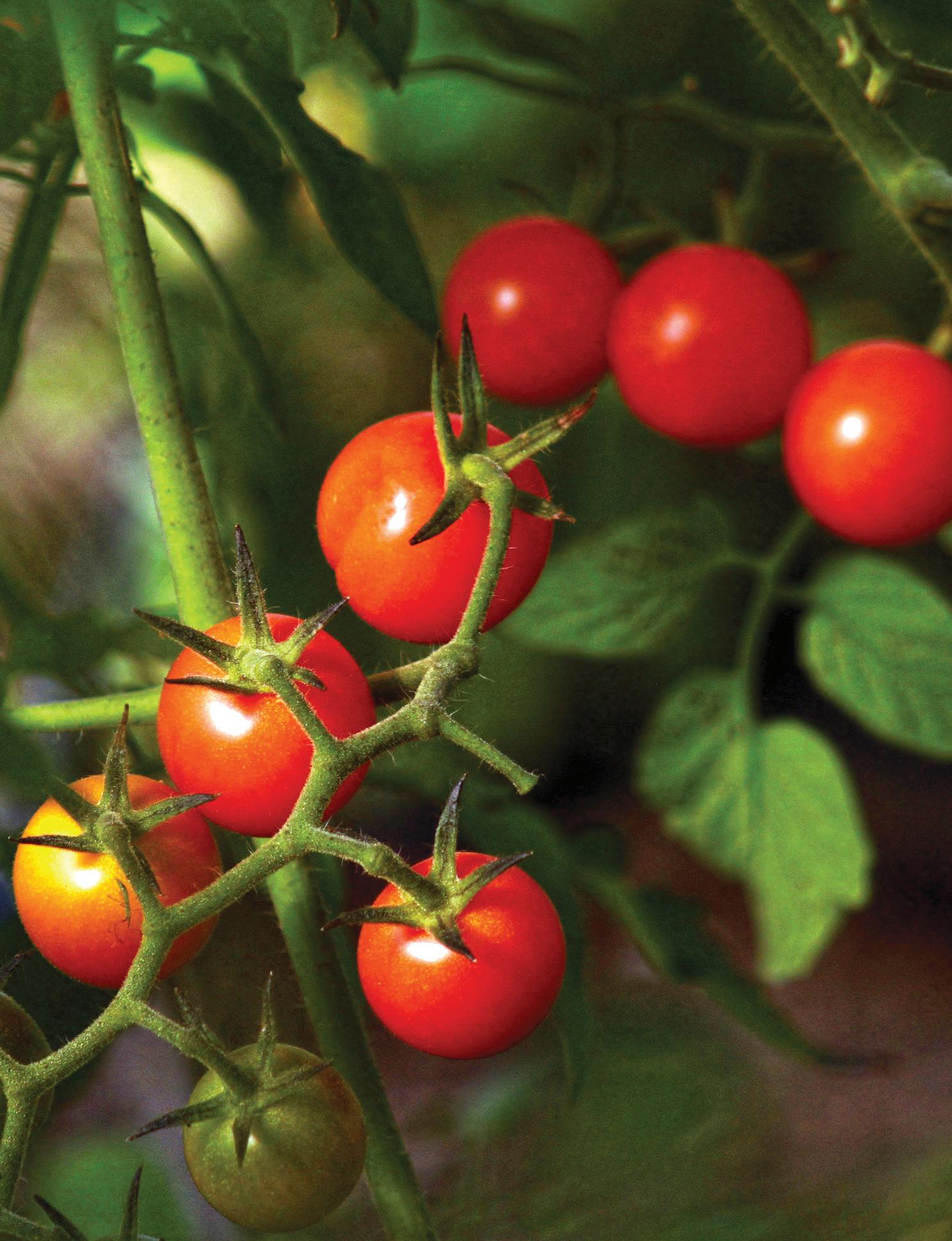 By Maddy Alley
By Maddy Alley
ON THE FARM
13 Mallory Watts’ Milkweed Farm is the little farm that could.
By Mollie Doyle
38 Predator or partner? Wily or not, we may have to coexist with coyotes.
By Kate Athearn
FEATURES
18 A ‘good pierogi’ story
Chef Krem Miskevich’s love of Polish pierogi.
By Catherine Young
22 Pretty plates Edible flowers add color and flavor to summer dishes.
By Catherine Walthers
24 Bees’ needs Pollinator Pathways Project creates pollination zones.
By Mollie Doyle
31 Family, friends, and food
The Taylors welcome folks to the Outermost Inn.
By Tina Miller
DRINKS
28 You say ramato, I say summer Italy’s answer to orange wine is all I want to drink.
By Sam Decker
IN SEASON
30 Fluke crudo
Fresh local fish is key for this dish.
By Tina Miller
FROM THE KITCHEN
35 Pesto with a past
The potent paste that tastes great on nearly everything.
By Neila Decker
DONE!
48 Whale of a fish tale
Artist and fisherman Kib Bramhall and the one that didn’t get away.
CONTENTS
in season 2023 5
Sadie Dix
COVER PHOTO BY MATT PELIKAN Halictus ligatus, a species of sweat bee, on butterfly weed.
Hello, summer! It’s been a minute since we had a normal summer. Normal can be interpreted as boring, but we are loving normal. With summer in full swing on the Vineyard, we are all busy bees. Speaking of bees, Mollie Doyle meets up with Betsy Fink, Luanne Johnson, and Matt Pelikan of the MV Pollinator Pathways Project, which takes us around to some Island farms where experiments on bee habitats are being studied.

We head way up-Island to experience a true family business in a dreamy location in Aquinnah. We catch up with the Taylor family at the Outermost Inn, where family, tradition, and hard work are always on display — not to mention gorgeous surroundings and delicious eats.
Also delicious are the ever-special, authentic pierogies created by Chef Krem Miskevich, handmade with whatever is local and in season, pure magic!
We think you will find a lot of pretty things in this issue: edible flowers, orange wine, bright-green summer pesto, and of course, a pretty little place called Milkweed Farm in Chilmark.


With summer in full swing, Islanders are working at a crazy pace — but no more than our amazing team that makes Edible happen. We are going to gush and thank our in-house crew, who leap from creating the weekly newspaper, The Martha’s Vineyard Times, right into our Edible VIneyard world. We couldn’t do it without these incredibly hard working geniuses —

Eagle eye and fearless creative director Kristofer Rabasca.



Production manager and multitasking king, Dave Plath. Crossing T’s and dotting I’s, our design queen Nicole Jackson. Foodie and proofreader Irene Ziebarth. Jenna Lambert and Sharisse ScottRawlins, our rockin’ sales team, bringing partners to support our mission at Edible Vineyard. They all help us focus on Our Food, Our Stories, and Our Community. Also, publishers Peter and Barbara Oberfest, who grabbed Edible Vineyard and brought it back from nearly fading away.

6 edible VINEYARD
REAL ESTATE - MARTHA’S VINEYARD Beetlebung Corner, Chilmark 508-645-3533 www.conroymv.com Real Estate Services Island Wide We are celebrating 50 years in business
EDITORS’ LETTER
Matt Pelikan
With UNCLE MIKE’S Herbs & Veggies you get quality, non-GMO plants that are selected for their ability to perform in our New England climate and are grown with Integrated Pest Managment (the good bugs eat the bad bugs) so you can feel good about growing organically at home.



On Martha’s Vineyard Uncle MIke’s herbs & veggies are sold exclusively at Jardin Mahoney. 45 Edgartown Vineyard Haven Road Oak Bluffs - 508.693.3511 www.jardinmahoneymv.com Follow us @JardinMahoney
Feel good about the food you grow.
About Out &
Attic at Waterside
Martha’s Vineyard has had a long and hushed history with alcohol sales, dating back to Prohibition times. In the Roaring Twenties, Aquinnah reportedly housed rum runners who hid their bounty under the sands of Nomans Land. One hundred years later, alcohol sales are still banned in one Vineyard town, but 2023 marks the first summer that alcohol can be sold without food in Vineyard Haven. The new prohibition-era restaurant The Attic, housing the largest bourbon collection on-Island, is now making its timely introduction to Vineyard Haven. Inside, photographs and history lessons about local rum runners, rum chasers, and the boats that battled for bourbon dot the walls. A creative tavern style menu paired with extensive cocktail options will take you on a delicious and devious trip back in time.
@theatticwaterside
MV Seafood Collaborative

This summer, the Martha’s Vineyard Seafood Collaborative is selling fresh and flash-frozen fish (say that five times fast) at the West Tisbury Farmers Market and through their Community Supported Fishery. Buying from and supporting our local fishing fleet, the fish will be quickly vacuum-packed and flash-frozen to preserve flavor and nutrition, offering a fresher than fresh option compared to fish sitting out in refrigerated cases. Choices will include black sea bass, flounder, scallops, scup, blue fish, striped bass, yellowfin, and bigeye tuna labeled with the vessel it was caught on. Summer and fall Community Supported Fishery memberships are available and include two to three monthly pickups of local seafood. vineyardseafood.org; @vineyardseafood
La Strada


Vineyard Haven’s Salvatore’s Restaurant team will open another year-round spot coming soon to Main Street called La Strada. The smaller space will focus on delivering the same authentic Italian dishes, but in a takeaway style for quick lunch and dinner pick up. They will also sell Italian groceries such as olives, wines, cheeses, sliced meats, and high-quality coffee. salvatoresristorante.com
North Tabor Farm
The farmstands on Martha’s Vineyard are special spots that embody the truest sense of farm-to-table, or more often, farm-topost-beach snack in the car ride home. This summer, North Tabor Farm is taking one step closer to your table with their new commercial kitchen. The farm’s fresh produce will be whipped up into salads,
8 edible VINEYARD OUT & ABOUT
WORDS Maddy Alley
Looking for fresh and local food? We’ve got you.
Courtesy Shored Up Digital
Bourbon on the rocks at the Attic.
bowls, sandwiches, and other goodies, then sold at the farmstand and the Farmers Market. The prepared food options will change with the growing season, and include the farm’s new unique crops such as tomatillos, husk cherry tomatoes, heirloom cucumbers, and squash. northtaborfarm.com; @northtaborfarm
Farmers Market
Less is not more at the West Tisbury Farmers Market this summer. There will be more vendors, selling more vegetables, more flowers, and more seafood, but more importantly, in a more inclusive way. The entire market will be accepting Supplemental Nutritional Assistance Program (SNAP) and Healthy Incentives Program (HIP) state funds that make healthy and local food more accessible for anyone needing financial help. There will also be more fun, with live music and pop-up vendors sprinkled in throughout the summer. wtfmarket.org;
@westtisburyfarmersmarket

Katie Leaird Pasta
Summertime means colorful plates of fresh fruit and vegetables, and now, pasta. Katie Leaird is combining her Italian cooking school education, which she admits stands no ground next to the time she spent learning from Italian grandmas, with her love of the Island that has drawn her back year after year. Katie is now based on Martha’s Vineyard fulltime, where she creates handmade pasta from scratch, using fresh Island eggs and vegetables to create a rainbow of products. Beets, red peppers, and spinach are incorporated into five different doughs to boost the nutrition and aesthetics of the pasta, resulting in a rainbow of options. The palettes of pasta will be available at the Edgartown Village Market this summer. katieleaird.com; @katieleairdfood
Pearl’s Plateau
Words you think of when you think about Martha’s Vineyard: beach, shark, pearl. Plateau? Probably not, at least not yet. This summer, Pearl’s Plateau is grilling up local seafood behind The Cove in Vineyard Haven. With music, games, and a raw bar, the only thing missing is a sunset view. Instead, diners can watch their food be grilled and shucked right in front of them, fresh as could be. Pearl’s Plateau is going to be the backyard party you wish you had been invited to, and now you are.

@pearlsplateau
Clambulance
Picture this: a warm summer evening, cotton candy clouds, flutes filled with bubbly, waves lapping on the shore. Ah, shucks, something’s missing. You don’t see food. It is an emergency — a raw bar emergency — admittedly the best type of emergency to have. In comes the Clambulance, lights flashing and sirens wailing, bringing fresh seafood to revive your crabby friends. Unfortunately, insurance doesn’t cover shell care. If you don’t want to shell out on a catered raw bar, the Clambulance team now sells emergency raw bar kits, with everything you need to shuck-from-home. The Clambulance pop-up raw bar is available for private events, and can be found at Vineyard Haven’s First Friday celebrations every month. The emergency raw bar kits are being shelled out at the Green Room and Backwater Trading. clambulancemv.com; @clambulancem
Aalia’s Coffee
Aaila’s in Oak Bluffs is splitting up. But don’t worry, in this case, two is better than one. Aaila’s AM will continue to serve coffee and morning meals, but when the lights go down, Aaila’s PM will turn into a tapas restaurant. Dinner options will include small Mediterranean-style plates accompanied by natural wines, beers, and music.
aaliascoffee.com; @aaliaspm






in season 2023 9 OUT & ABOUT
Tina Miller
Courtesy Clambulance
Everything is farm fresh at the West Tisbury Farmers Market.
Raw bar by Clambulance to the rescue.
S&S Kitchenette is shaking things up with different themed dinners, cooking classes, guest chefs, and karaoke nights throughout the season.
sskitchenette.com; @sskitchenettemv
Midnight Taco
Oak Bluffs is getting a new late night snack spot, for those who prefer a savory option over ice cream and donuts after dark. Midnight Taco, a takeout spot with a rotating coastal Mexican inspired menu will be satiating those without a sweet tooth seven days a week.


@midnighttacomv
Homeport
After over almost a century of serving sunset snacks, Homeport is making steps to modernize while maintaining their beloved traditions. Functionally, there is new decking, furniture, and bathrooms that smell like they belong in a fancy restaurant. The raw bar has been replaced with a zero-proof alcohol bar serving mocktails that can be enjoyed alone or topped off with your own alcohol. The kitchen will continue to serve traditional seafood and local favorites from the front and back doors. Out front, an elevated menu will include three courses of creative combinations. This summer the back door will also be reopening, serving takeaway meals and picnics that pair perfectly with Menemsha’s sunsets. thehomeportmv.com;
@thehomeportmv
Edgartown Village Market
Among the beauty of downtown Edgartown, between blue hydrangeas and white columns, there is little space for parking, a bittersweet reality we all know too well. This summer, the new Edgartown Village Market is fighting back — providing a walkable location for Edgartown residents, and bikeable for the rest of the Island, to stock up on local goods. On Tuesdays, between 9 am and 2 pm, the lower lawn at the Dr. Daniel Fisher
House will fill with 20 stalls selling locally grown produce, food, and flowers, and Island-made arts and crafts. You will be able to fill your basket with everything from picnic provisions to artisanal souvenirs. Just remember, you will have to carry it all home, unless you are one of the lucky few who found a nearby parking spot. edgartownvillagemarket.com;
@edgartownvillagemarket
S&S Kitchenette pop-ups
The soundtrack of dirty bananas and fried oysters can be an appealing option to play on repeat all summer long, but

Cottage City at Beach Road
Beach Road restaurant is located on the edge of the lagoon in Vineyard Haven. The water views are often dotted with silhouettes raking in littlenecks to shuck and serve in true pond-to-table style. This summer, the restaurant has a new raw bar, operated by Cottage City Oysters, that will serve fresh and local littlenecks and oysters, harvested only hours before shuck-time. You can sit at the raw bar for a slippery snack or add the goodies to a seated restaurant meal. cottagecityoysters.com; @cottagecityoysters Beachroadmv.com;
@beachroadmv






10 edible VINEYARD
OUT & ABOUT
Tina Miller
NIcole Jackson
Larisa Stinga Photography
Spring Sheldon is at the helm at S&S Kitchenette.
Midnight Taco open more than just late nights.
A complete lobster dinner at Homeport in Menemsha.
@EDIBLEVINEYARD






Davis House Gallery 985 State Road - West Tisbury 508-693-4691 · www.allenwhiting.com
Gallery Open July 1 - September 3 Saturdays & Sundays from 1-6 pm AND By appointment




in season 2023 11 Come experience the bounty We are now open year round Growing together with you, our community We’re Social! Follow us on Instagram
“Moonrise West Tisbury”
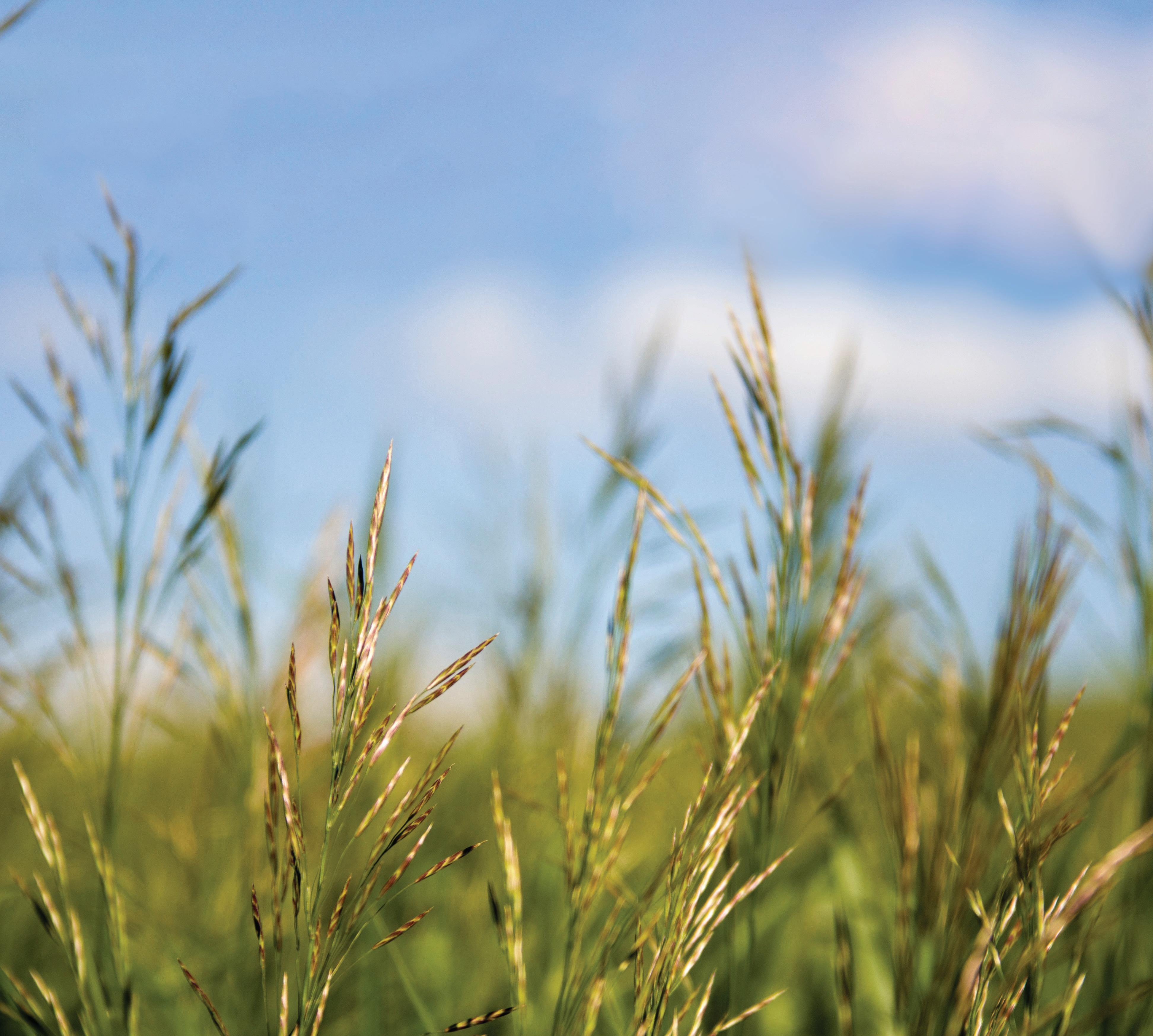







in season 2023 13
The little farm that could ON THE FARM
Mallory Watts of Milkweed Farm in Chilmark.
Mallory Watts’ Milkweed Farm finds her a long way from medical school, but right where she wants to be.
WORDS Mollie Doyle IMAGES Sadie Dix
Mallory Watts’
first Martha’s Vineyard experience was the Island in March in the middle of a snowstorm. Gray, windy, cold, and isolated. It was 2017 and she was here to check in on a family’s Chilmark property. “Even though so much of where we are standing was covered in snow and completely overgrown, I immediately saw the potential. In 2020, it was so wild in some areas, that when Mitchell Posin and Ned Allen-Posin helped me put in the deer fencing, we had to use Google Earth to map out fence lines.” She laughs and continues, “It’s been a process. We started with twelve beds. Now we have one hundred.”
Note that when Mallory says, “We started with twelve beds” she means “me.” Until only very recently, Chilmark’s Milkweed Farm has been just her, clearing land, creating beds, cultivating the land with “the help of family and a few friends.” Five years in, Mallory has just recently hired farmhand Graham Webb to help. “I built the

greenhouse by myself. I don’t recommend doing that,” she laughs. “I mean, of course I had help installing a new well, putting in the sink and getting the electricity running, but the rest, I just figured out.” It must be noted that her first greenhouse, which is about 20 x 30 feet, looks professionally installed. Mallory points to the farm’s 100-foot hoop
house. “My mom helped me build that.”
Speaking of her mom, not too long ago, Mallory’s mom (and dad) thought her daughter was going to be a doctor. Mallory’s journey from growing up in Bloomfield Hills, Michigan, and graduating with a double major in International Studies and Spanish while following a pre-med track from the University of Michigan to being a 31-year-old farmer on Martha’s VIneyard weaves and winds. But all good life evolution stories do. After getting her undergraduate degree, Mallory moved east to work for a Park Avenue plastic surgeon. She lived in Stamford, Connecticut — New York rent was too steep — and commuted into Manhattan. “I was trying to figure out if I wanted to go to medical school,” she says. “I had taken a food systems course in college and loved the material, so I was also thinking and reading about sustainable food systems and farms and how they supported health.”
A mentor helped her sift through her occupational choices, and Mallory realized that medical school was not her destiny. She quit her job at the surgeon’s office and
14 edible VINEYARD ON THE FARM The little farm that could
Milkweed Farm.





in season 2023 15
The little farm that could ON THE FARM
One of my priorities is to not overgrow and waste food by growing more than can or will be eaten.
On the
–Mallory Watts
farm.
Spring salad greens.
The hand-built greenhouse at Milkweed Farm.
Mallory on the farm.
Flowering chives at the farm.
ON THE FARM The little farm that could
enrolled in the Youth Farm Urban Agriculture Certification Program in Brooklyn, N.Y., which is a seven-month-long program. To support herself, she took odd jobs and worked as an executive assistant. Shortly after the course finished, a recruiter contacted her to see if she would like to work for a family as their personal assistant. She met them. And, as fate would have it, the family happened to share Mallory’s passion for food systems, plants, farming, and biodiversity, and had a small plot of land in Chilmark that needed stewarding, which led to her 2017 storm visit.
Milkweed Farm, which was officially born in 2018 “with temporary deer fencing,” now grows garlic, fresh herbs,

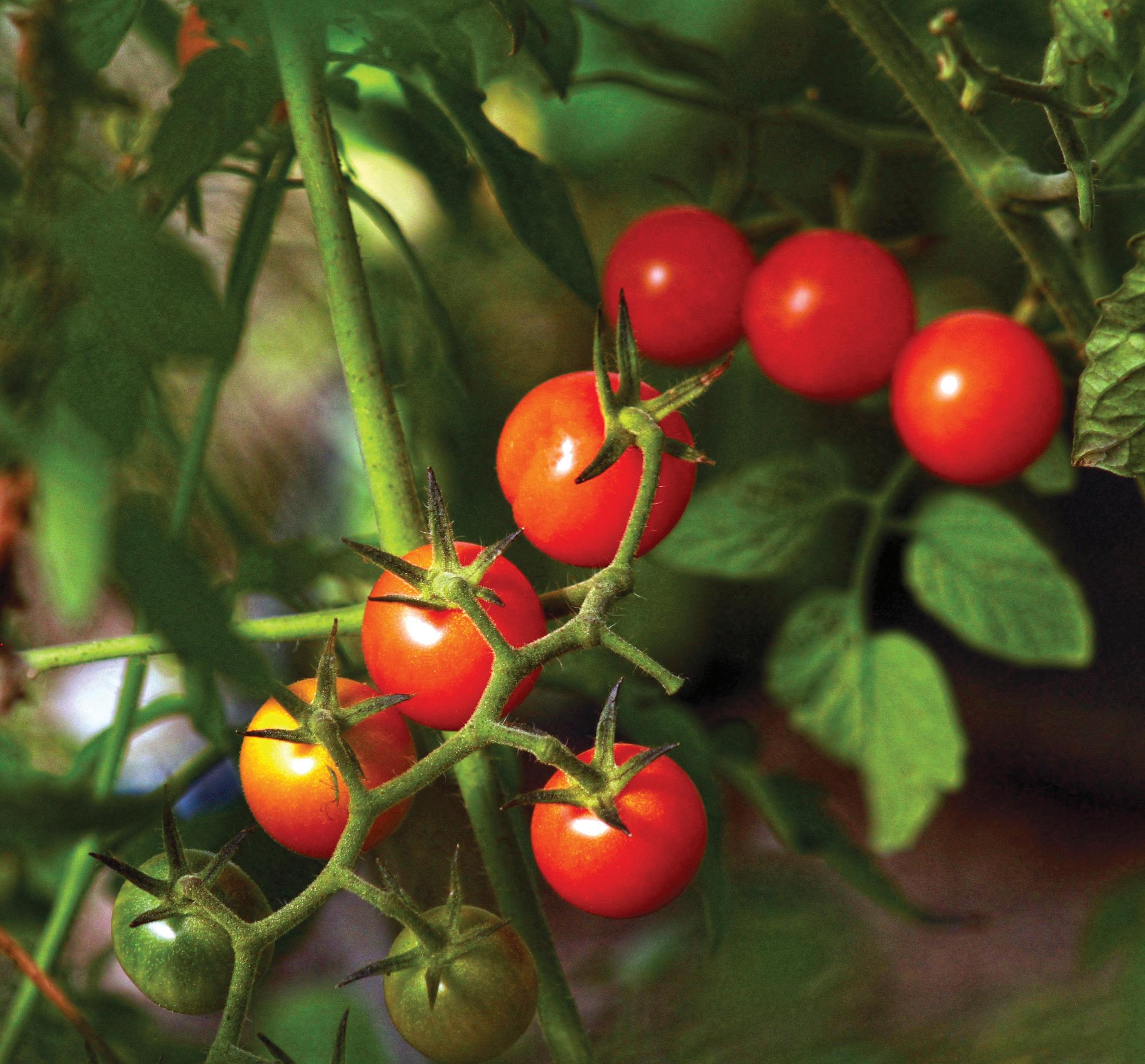
tomatoes, greens, kale, strawberries, chard, peppers, peas, persimmons, paw paws, and hazelnuts, among other fruits and vegetables on a verdant acre. While the farm’s total property is about 12 acres, Mallory wanted to keep the cultivated area to a smaller scale. “One of my priorities is to not overgrow and waste food by growing more than can or will be eaten.” Milkweed Farm sells its produce at the West Tisbury Farmers Market on Wednesdays and Saturdays. Alchemy, Camp Jabberwocky, the Covington, Grey Barn, MV Salads, and the Fish House all source from Mallory. “We donate any leftovers from the Farmers Market to the Island Food Pantry,” she says.
As the farm has evolved, Mallory and the family who owns the land have defined a few principles that guide the farm’s growing process. Their approach largely embraces regenerative landcare practices. They rotate crops annually, use compost applications to enrich the soil and boost its microbial activity, have cover crops, follow integrated pest management protocols, and do not till so there is less erosion, less disruption of the soil’s microbial life, and less carbon released from the soil.

But the even more exciting work that Mallory is doing with the land is the way she is thinking about the farm’s overall ecology and increasing the biodiversity of the land, including native plant species. She points out two old apple trees, a beach plum hedge, and a paw paw grove that will support the farm’s understory. “I really enjoy the exercise of trying to solve how to grow as much food on a small plot of land. This way I can take care of the soil better, I can also use less water and calculate yields more accurately. It’s really cool to see how we can think about and define success. Are we maximizing diversity and growing beautiful food?”
Mallory is not the first enterprising woman to inhabit this property. The farm’s house was built in 1865 by Freeman Hancock. In 1904, Freeman’s son, Dana, inherited the house and sold vegetables and eggs from the farm. In 1922, Dana’s daughter, Priscilla, began making chocolates, which she trademarked, “The Priscilla Hancock Candies.” Priscilla lived with her partner Lucy Wiig and ran her chocolate business out of the house until 1956. Hancock Beach is named after her.
“I find inspiration from her and this property. People stop by and I hear stories from people who knew Priscilla. It’s special to hear about a woman who was my age, down here making chocolates about 100 years ago. In many ways, I want to honor her and the work she did here on this land — to keep the work she did alive, honoring her and her family.”
And medicine has not left Mallory’s life entirely. She is engaged to Janna Kramer, a nurse educator at the Martha’s Vineyard Hospital. They went to high school together and reconnected in New York. “Janna worked at NYU Langone in 2020. It was an intense time.” Mallory pauses for a moment. “Well, after that, I feel even more thankful for the land and the space here. We’re getting married in September. And I get to grow food. It’s pretty good.”
16 edible VINEYARD
Ruby chard at Milkweed Farm.
Freshly harvested basil at the farm.
Tomato season at Milkweed Farm.
Skewered and grilled
Kabobs are perfect for this time of year.
This is the tim e of year we want to spend as much time outside as possible, that includes cooking, so fire up your grill!
Skewers filled with veggies and/ or meat or chicken are always a party pleaser, though you may have a bit of prep. Once the skewers are made, they can sit in the fridge, and come dinner time, the hard part is done! Just grill and serve. They will cook up quickly and neatly.
At Cronig’s Markets, they have a great selection of natural and organic chicken, as well as pork and beef to choose from. For this recipe, we love chicken and use Bragg Liquid Aminos, which is very similar to soy sauce in flavor; it’s made from soy, not wheat, so it is gluten-free and loaded with 16 amino acids. And it’s delicious. We also use shiitake mushrooms, which are juicy and flavorful.
by Cronig’s Markets and Healthy Additions

Grilled Chicken Kabobs
Serves 6
2 lbs. boneless chicken breast, cut into cubes for skewers (Boneless, skinless thighs, cubed pork, or steak could work as well.)
2 Tbsp. toasted sesame oil
2 Tbsp. olive oil
1 tsp. honey
1 tsp. garlic-chili paste
2 medium peeled garlic cloves, grated (a microplane is ideal)
1 Tbsp. fresh peeled ginger
1 Tbsp. brown mustard
3 Tbsp. Bragg Liquid Aminos, or you can use Tamari, also gluten-free. Zest and juice one orange
20 larger shiitake tops
6 scallions, trim the very bottom threads, and just the very end of the scallions, saving as much of the whole scallion as possible
1 medium zucchini, halved lengthwise and sliced into one-inch pieces.
You will need wooden skewers, probably six, soaked in cold water for at least 30 minutes. Combine all ingredients except chicken breast. Whisk well. Add chicken chunks, combine, and let marinate for about one hour in the fridge.
To create skewers, start with a shiitake cap, skewer through the middle of the cap, and push to the end. Thread chicken cube, then zucchini, repeat, shiitake, chicken, zucchini, add one whole scallion, fold in half, per skewer, continue and end with shiitake.

To grill, be sure your grill is hot! Spray with olive oil or vegetable oil spray and lay loaded skewers on the hot grill. Close the cover and grill for about 4 minutes, then turn. At this point, you can keep the grill top open to finish cooking slowly.
This story and recipe was brought to you by:
in season 2023 17
Sponsored
A ‘Good Pierogi’ Story

18 edible VINEYARD FEATURE
WORDS Catherine Young IMAGES Anna Brody
Chef Krem Miskevich talks about the history and the love behind Polish pierogi.
Chef Krem Miskevich in the kitchen.
I recently wondered, what sets Polish pierogi apart?
Typically thoughtful, Krem Miskevich, a talented chef and pierogi aficionado, responded :

Pierogi are not vareniki, I’ve a lways said that, but when I really think about it, it isn’t so easy to isolate the differences among Eastern European dumplings. Maybe, I just want Poland’s pierogi to be unique because I love them. Speaking for myself, my dough never contains egg — I want it light and silky — and my pierogi are always filled with what is seasonally at its peak, potatoes and cheese sometimes, but just as often local meat, fresh berries, or when I have them, I braise young carrots. This is something I learned growing up. In my experience,
the thing that is most essential to our food is that each dish is cooked and eaten as a tribute to what is available. In Poland, that means we never eat asparagus but for one month a year, same with mushrooms and strawberries — though sometimes they run a bit longer. We wait eagerly for each fruit and vegetable to ripen (and anticipate that the cooking will change as the season progresses and the ingredient matures). We eat what is perfect then move on, savoring as we go. Pierogi, filled with what we’ve grown or gathered, are at heart humble, like a lot of Polish food. That said, when made well, they are extraordinary because every tasty bite connects us both to our history and a specific place and time.
I first encountered Krem at a pop-up at State Road restaurant in 2021. Krem cooked a delicious progression of dishes using Island ingredients, all inspired by the food they ate growing
up in Poland. The dinner was organized by Elana Carlson (founder of Fantyze Bagels) who’d met Krem at Kismet, the Los Angeles restaurant where Krem worked as sous chef. Krem’s path to a summer on Martha’s Vineyard was not the usual one. Born in 1990, a year after the fall of the Berlin Wall and a month after Lech Walesa was elected in the country’s first free election, Krem grew up in Warsaw. Krem’s father, a Russian raised in the U.S. (his parents immigrated), left before Krem was two.
Krem remembers:
I was popular as a teenager and definitely liked to have fun. I was not much interested in studying, and my mom was stretched thin in those years. I guess
in season 2023 19 A ‘good pierogi’ story FEATURE
Ingredients for sweet blueberry pierogies.
I was a lot. I’d never had any contact with my father but she reached out to him (he was living in Russia). He came to Warsaw, offered me an American passport and invited me to LA to stay with my grandparents. I was 17, eager for a change and to meet the rest of my family, so I got on a plane.
When I got to California, I enrolled in Beverly Hills High. Honestly, it was tough. I did not yet have the words to express my identity but I knew I had little or nothing in common with most of the kids around me. They made it clear they felt the same. I hung on for three months then went back home to finish high school.
I returned to LA planning to enroll in film school. I rethought things when a friend suggested I’d be better off becoming a chef. I was surprised because I didn’t cook. I have very strong food memories, but I never spent time in the kitchen (since then I’ve been told that I’d hop up whenever somebody in our group was hungry — I have no recollection, though I have so much energy I imagine it’s true). To make a long story short, I wound up enrolling in the Cordon Bleu Cooking School in Los Angeles. I probably could have saved money by wriggling my way into a restaurant job but, as things turned out, I got a lot from my fi -

nal “stage” at Fiskebaren in Copenhagen and I found my degree was respected and helpful when I returned to Poland.
After graduation I started work in Warsaw at a restaurant connected to a nightclub. It was a casual place, with a small staff and the menu changed every day. I didn’t have much experience but I kept moving, which meant, in that experimental hothouse, I got to try things. It was crazy but I loved it. I’d cook, then end the night dancing to my favorite DJs. Looking back, it was probably the least healthy place I’ve ever cooked, but I learned in that creative chaos.
I left after about a year and went on to cook in a couple of other kitchens in the city. I was good at my work, but back then, my job wasn’t what guided me. When my girlfriend suggested we move to Barcelona, I was ready to go.
I wound up at Mé. The chef was from Vietnam. He was a war refugee who was settled in Texas. He spent time in New Orleans and worked for Jose Andrés who sent him to Barcelona. He decided to stay in Spain and bring it all together — we served Vietnamese, Cajun, Catalan food — a wild mix but it worked.
Three years later, when Mé shut, I
20 edible VINEYARD
A ‘good pierogi’ story
FEATURE
This is something I learned growing up.
In my experience, the thing that is most essential to our food is that each dish is cooked and eaten as a tribute to what is available.
–Krem Miskevich
Making sweet pierogies.
A PIEROGI PRIMER
A taste for pierogi is thought to have spread west from China. Legend has it that the beloved dumpling was brought from Kyiv by Hyacinth of Poland, a Dominican monk in the 13th century. The story goes that Hyacinth used pierogi to feed the needy. By 1682, pierogi had become popular with the aristocracy, the first Polish cookbook includes a recipe for pierogi made with a fine dough stuffed with veal kidneys. Over the next centuries, pierogi came to be associated with celebrations,
each holiday with a special variety. The popularity of pierogi has grown and spread in Poland ever since. In lean times, people filled theirs with what they had — potatoes, groats, buckwheat, or local fruit. As Krem says, today’s fillings are dictated by the cook, season and occasion.

As is typical, Krem makes both savory meat and vegetable pierogi and also makes sweet ones. The same dough (see recipe) is used for all. Krem either simmers pierogi in gently boiling water then serves them, or goes on to sauté them. In Poland they use clarified butter for frying but a mix-
ture of oil and butter will work just fine.
Pierogi freeze well. When that’s the plan, Krem recommends blanching the filled dumplings in boiling water for 30 seconds, transferring them to an oiled baking sheet (or plate) with a slotted spoon, then turning them over after 30 seconds so both sides cool evenly. Once the pierogi stop steaming, freeze them as they are, then transfer them to a freezer bag. They will keep for at least 3 months. To serve, simply drop the frozen pierogi in boiling water, allow them to float, then cook them for an additional 1½ to 2 minutes.
felt the loss, so I headed home. I was in Warsaw regrouping when my brother called asking me to help him develop an ice cream brand. I didn’t hesitate. It took years, but my brother’s ice cream, Moloko, is now available on the West Coast (it is terrific). I moved back to California and worked with him as long as I could, but didn’t stay the course; my shrinking bank account forced me to find regular income.
I took a position at Jon & Vinny’s, working all the stations, filling in as needed. Because pasta was the busiest, I spent the most time there, so much so that I started to get sick (I still have trouble with processed gluten — luckily I can work with high quality unbleached flour). That’s where things stood when I heard Sarah Hymanson and Sara Kramer were going to lead a team cooking market-driven food with Jewish/Middle Eastern flavors. At Kismet, a wonderful restaurant where I spent three and a half years, I realized food wasn’t just my job, it is my life.
In 2020, when the pandemic hit, Kismet had to shift; it became a grocery selling fresh and prepared food. It was time to try my own thing. I made pierogi, froze them and sold them from my kitchen. I came up with a name (Good Pierogi), a friend helped with graphics and I was off and running. All formed by hand, my first run of 50 bags sold out immediately. It was grueling, but I realized I was doing what I truly wanted to do.
I heard about Martha’s Vineyard from Elana, she worked at Kismet “off-season.” In 2021, I decided to check it out. I found a summer job as a private chef, did pop-ups,
Continued on page 36
in season 2023 21 A ‘good pierogi’ story FEATURE
Krem forming and sealing pierogies.
This is my invariable advice to people: Learn how to cook — try new recipes, learn from your mistakes, be fearless, and above all — have fun. In the spirit of Julia Child and having fun in the kitchen, learning about edible flowers can bring art, beauty, and whimsy to your cooking time.
While not all flowers are edible, like daffodils or buttercups, many are perfectly fine to eat and use. It’s still not that easy to find edible flowers in supermarkets, so growing them or looking around your surroundings is probably the best way to start. (See below for one great source of local edible bouquets.) Each Island spring you can find dainty violets hiding in your untreated grass, white and pink roses blooming along beach roads, and yellow mustard flowers among wild spring greens — all tasty. Summer, however, is the prime time for edible flowers, even though you find some real beauties in the fall, including pineapple sage, which blooms with elongated scarlet flowers through October. The pineapple sage flowers taste sweet and fruity, with a hint of mint and the scent of pineapple when crushed.
Pretty Plates
WORDS Catherine Walthers
When you discover and start using edible flowers, you gain an additional tool in the kitchen. Dashes of purples, yellows, pinks, and oranges — the palette of edible flowers makes food and drinks look even more appealing as they leave your kitchen. Sometimes a whole flower works best, maybe a red-orange nasturtium topping a salad or floating in a punch bowl.
My eyes opened to edible flowers the year I planted an experimental section of medicinal herbs, not far from the culinary herbs like parsley and basil. I learned that quite a few of the medicinal
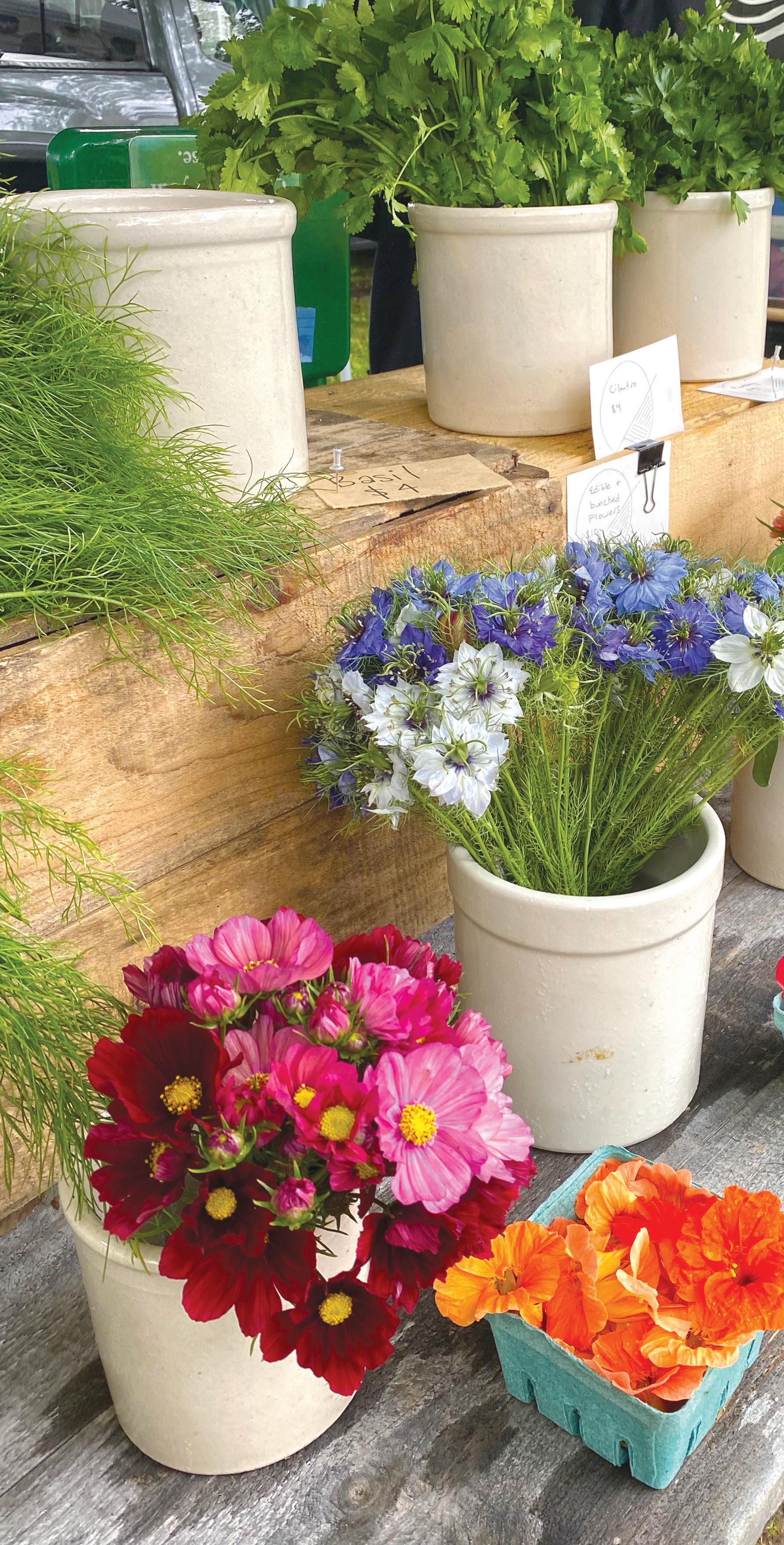
22 edible VINEYARD
FEATURE Pretty Plates
Edible flowers add more color and flavor to your summer dishes.
Tina Miller
herbs — like borage, calendula, and echinacea — bloom all summer with edible flowers and this became the prettiest section. I also learned how useful they could be. The daisy-like orange and yellow calendula flowers made their appearance in almost everything, from salads to yogurt parfaits to weekend crepes. The borage flower, with its star shape and bluish-purple leaves, became a favorite. It tastes like cucumber, and has been around since an -
anything special,” says Gilbert. The edible dill blossoms come in wispy, wide-spreading formations called “umbels” with tiny golden yellow petals that look nice on food platters. This season, Gilbert is trying a new Asian flowering herb called “Tong Hao.” She bought seeds from Second Generation, a seed company that specializes in heirloom Asian plants. It describes Tong Hao as a type of chrysanthemum, having “a big, bright, fresh herby flavor, with a crunchy, juicy stem that makes it the highlight of any hot pot.”
While some flowers have interesting flavors like pineapple and cucumber, many
Continued on page 42
cient times, said to impart courage and trigger positive thoughts. I popped one in my mouth each time I walked by. I’m just beginning to learn about medicinal uses for both flowers and leaves. Echinacea flowers, or coneflowers, have been used in both traditional and folk medicine for centuries, often brewed in teas. Pineapple sage flowers are said to have antidepressant and anti-anxiety properties.
“Many edible flowers are nutritional and medicinal powerhouses,” says Rebecca Gilbert of Native Earth Teaching Farm in Chilmark. When she wrote her book “Weedy Wisdom for the Curious Forager,” published last year, she included a whole chapter called Eating Flowers. Along with recipes for candied flowers or making tea blends with flowers, she suggests floating edible flowers in hot or cold soups, flavoring butter cookies and cakes, freezing in ice cubes or adding to butters, jams, honeys, and sugars. “They always seem like a special kind of gift,” she says. “And they make such a dramatic statement, they can really make a forager shine!”
Gilbert reminds us not to overlook the garden plants that produce their own edible flowers, like thyme, cilantro, and dill, as well as squash, arugula, kale, and beans. The orange flowers from scarlet runner beans are among her favorites, and those might look great with a plate of tomatoes. The “side effect is that you don’t have to plant

A list of edible flowers from Rebecca Gilbert’s “Weedy Wisdom for the Curious Forager, Common Wild Plants to Nourish Your Body & Soul.”
Anise hyssop
Apple blossom (in moderation)
Arugula
Basil
Bachelor’s buttons
Bergamot
Black locust
Borage
Calendula
Carrot
Catnip
Chamomile
Chickweed
Chicory
Chrysanthemum
Citrus blossom
Clover
(in moderation)
Coriander
Dahlia
Daisy
Dandelion
Dayflower
Daylily
Dill
Elderflower (no stems)
Evening primrose
Fennel
Garlic mustard
Gem marigold
Geranium (scented)

Gladiola
Goldenrod
Hibiscus
Hollyhock
Hyssop
Jasmine
Johnny jump-up
Lavender
Lilac
Linden
Mint
Mullein
Mustard
Myrtle (in moderation)
Nasturtium
Okra
Oregano
Pansy
Pear blossom
(in moderation)
Primrose
Radish
Rosemary
Rose
Sage Snapdragon
Thyme
Tulip
Turnip
Violet Yarrow
in season 2023 23
Pretty Plates FEATURE
Display of edible flowers from Beetlebung Farm at the West Tisbury Farmers Market.
Calendula, bachelor buttons, nasturtium, lavender, and bee balm (bergamot).
Catherine Walthers
Anthidium manicatum, commonly called the European wool carder bee, buzzes around cat mint.

24 edible VINEYARD FEATURE Bees’ Needs
There are many cool environmental initiatives on the Island, but in our opinion, one of the most exciting is the MV Pollinator Pathways Project, which is run in collaboration with Biodiversity Works, the Betsy and Jesse Fink Family Foundation, and eight participating Martha’s Vineyard farms.
For those not familiar with Biodiversity Works, it was founded in 2011 by Luanne Johnson. While there are many Vineyard environmental and conservation organizations, Biodiversity Works is the first to be dedicated to monitoring and researching the Island’s rich wildlife. Biodiversity Works partners with other Island conservation groups, along with state and national agencies, community members, students and scientists to look at, think about, and better understand the community of animals we live amongst. They track northern long-eared bats, spotted turtles, snakes, beach nesting birds, otters, willets, kingfishers, swallows and now, bees!
BE ES’ N EEDS
MV Pollinator Pathways Project creates pollination zones on Island farms.
Founder Luanne Johnson explains, “I’d been living and working here [on Martha’s Vineyard] for a long time, working for a lot of Island conservation organizations. I realized the wildlife needed protecting, and I wanted to think more broadly about habitat. Wildlife does not stop at the edge of someone’s yard. Animals certainly don’t think about that. They go where the resources are. So what is happening on an open compost pile, under a birdfeeder is also affecting what happens with the animal population. So we need to think about the whole picture. We work with environmental organizations and with homeowners because conservation land isn’t going to save the biodiversity on the Island.”
Luanne continues, “Animals need to be able to move, and we need to all be thinking about the wild land-private land interface.”
Luanne points out that we are pretty lucky here on the Island. We don’t have as many large-scale developments as we see
elsewhere — like on the Cape. And, when it comes to nature, the culture of our community here essentially does want to do the right thing. “There are so many organizations and individual advocates,” Luanne says. One of these individuals is Betsy Fink.
For those who do not know Betsy Fink, she is the co-founder of the Betsy and Jesse Fink Family Foundation, which funds projects that move “communities toward a more balanced, sustainable relationship with the environment.” The foundation has done extraordinary work, funding leading food waste projects here on the Island and around the country — from New York to Arizona — and biodiversity efforts from here on the Island to the Arctic. The MV Pollinator Pathways Project is Betsy’s brainchild.
She explains how it all started: “From 2005 to 2016 we owned and operated a 72-acre farm in Wilton, Conn., where we raised livestock and had extensive vegeta-
ble production. In addition to cultivating a community around organic foods, healthy eating, and food access and equity, the farm also served as a living laboratory and educational tool for the community. In our fields, we experimented with hedgerows and insectary plantings and saw a direct correlation between supporting pollinators through biodiversity efforts and an increase in yield. These findings, along with our focus on supporting food systems and biodiversity through the Martha’s Vineyard Atlas of Life, led us to think about biodiversity in the context of agricultural lands on Martha’s Vineyard, since they represent a substantial opportunity for biodiversity conservation (roughly 1,000 acres on the Vineyard).”
The Martha’s Vineyard Atlas of Life (MVAL), another collaboration between the Betsy and Jesse Fink Family Foundation and BiodiversityWorks, is an online platform that
in season 2023 25 Bees’ Needs FEATURE
WORDS Mollie Doyle IMAGES Matt Pelikan
provides a centralized resource for the public to deepen its knowledge of the Vineyard’s plants and animals. Islanders can also share their observations. The MVAL plays a role in the data collection for the Pollinator Pathways Project on farms, but we will get to this in a moment. For now, back to Betsy.
“In November 2021, our Foundation team made a number of site visits to Island farms and hosted a convening with farmers where we learned that across the board everyone is already engaging with regenerative and biodiversity-sustaining practices, which is amazing, but that ultimately there is a limited ability to devote resources aimed
solely at promoting biodiversity. Using feedback from the farm teams as a guide, we considered how we could provide the Island’s agricultural community with technical and financial support for biodiversity initiatives and this led to launching the MV Pollinator Pathways project,” Betsy tells us. “Our Foundation team had been thinking for some time about how to promote and support biodiversity on the Island at scale, specifically through pollinator work with Island-wide linkages. When we made our site visits to farms with Fink Fellow Matt Pelikan, our partner from the Xerces Society, and Molly Jacboson, a pollinator ecologist
from SUNY-ESF’s Restoration Science Center (and also a Fink Fellow), it was incredibly impressive how willing the farms were to consider the management opportunities presented to them, and their brainstorming about how biodiversity-supportive practices could be incorporated into their already heavy workload while still allowing them to meet their bottom line for food production. It was the genuine enthusiasm and open-mindedness of the agricultural community that made farms a natural jumping-off point for the work.”
Beyond being a Fink Fellow, Matt Pelikan is a naturalist and writer who has

FEATURE Bees’ Needs
Wildlife does not stop at the edge of someone’s yard. Animals certainly don’t think about that. They go where the resources are.
26 edible VINEYARD
–Luanne Johnson
Sphex ichneumoneus, known as the great golden digger wasp.
been involved in conservation on Martha’s Vineyard for 26 years. He has written extensively for local and regional publications about our habitats and spent 12 years surveying Orthoptera (a.k.a. grasshoppers, crickets, and katydids) on Martha’s Vineyard. When Edible sat down with him, he told us, “Farms are an important habitat. And when we were kicking ideas around for what would promote more biodiversity and be a feasible, effective proj-
ect, we came up with this idea of creating pollination zones on Island farms.”

In early 2022, the Fink Foundation approached Island farms about creating small pollinator gardens in and amongst or adjacent to their crops. Beetlebung Farm, North Tabor Farm, Whippoorwill Farm, Mermaid Farm, Morning Glory Farm, the Farm Institute, Thimble Farm, and Slough Farm agreed. Biodiversity Works, with the key help of Elisabeth Sheldon, es -
tablished and planted the plots, which are roughly 5 x 50 feet at each farm. Elisabeth planted eight or nine species of plants and put wood chips down to discourage weeds. It should also be noted that Elisabeth also maintains the plots for each farm. “We wondered, what if we pick out a small number of plants and see if adding them increases biodiversity. We used one native aster,
Continued on page 44

in season 2023 27
Bees’ Needs FEATURE
We also knew that honeybees are socially dominant, but I soon learned that they are highly motivated fascists, and they are highly selective. They want one nectar, one pollen resource.
–Matt Pelikan
A hairy belted miner bee, Andrena hirticincta, on goldenrod.
It’s official: Pinot grigio is cool again. Your reaction to the “again” part of this statement probably says something about your age, and even more about your lifestyle choices in the 1990s. For example, did you own at least one pair of boat shoes? Was Chicken Marbella (from “The Silver Palate Cookbook”) a dinner party staple you could whip up on the fly?
If you’re nodding emphatically, then you, dear boomer, not only lived through pinot grigio’s golden age — you nudged it along. (Remember all those bottles of Santa Margherita piled up in the recycling?)
Cursive fonts, pale straw hues, squeakyclean caramel apple flavors — 90s era pinot grigio was, as they say, a vibe.
Then Y2K arrived, prompting mass anxiety — and, inevitably, the need to quell it. One popular remedy — at least according to sales data — was pinot grigio. Between 1999 and 2000, sales surged 40 percent (Wine Spectator), initiating a decade of frenzied growth. By the time Real Housewives of New York City star Ramona Singer launched her own brand in 2012, pinot grigio had become a meme. But fame is not the same thing as social capital — and pinot grigio’s had long since dried up.
Now, shockingly, pinot grigio is making a comeback — but the new version is not what you’d expect. I’m talking, of course, about ramato — a traditional style of skin-fermented pinot grigio with roots in Friuli, Italy’s idiosyncratic orange wine mecca (a reputation revived in the 1990s by the wizardly Josko Gravner).
While the best expressions of ramato are probably still made in Friuli, producers around the world are jumping into the fray. (The upside of pinot grigio’s half-century of global domination is that there are plenty of grapes to go around). Two regions I’m keeping my eye on are Oregon’s Willamette Valley and Alsace in northeast France.

28 edible VINEYARD DRINKS
Why Italy’s answer to orange wine is all I want to drink.
You say ramato, I say summer
Terah Bajjaliah's production is based in Northern California’s Santa Clara Valley.
Courtesy Terah Wine Co.
WORDS Sam Decker
So what’s the difference between ramato and this broader category of skin-fermented whites (a.k.a. orange wine)? It comes down to the raw materials: orange wine can be made from any white grape (though some work better than others), whereas ramato must be made entirely from pinot grigio. In short, if orange wine needs white grapes, then ramato needs gray grapes (grigio means gray in Italian, a reference to the variety’s grayish pink skin).
Plot twist: pinot grigio is actually from France. Burgundy, to be precise — home also to the no toriously finicky pinot noir. Prone to mutation, pinot noir vines are known to randomly sprout grape clusters with little or no pigment. Eventually, these odd balls were given names: no pigment: pinot blanc. A smidge of pigment: pinot gris. Yes, pinot gris and pinot grigio are the same thing (like croissant and cornetto).
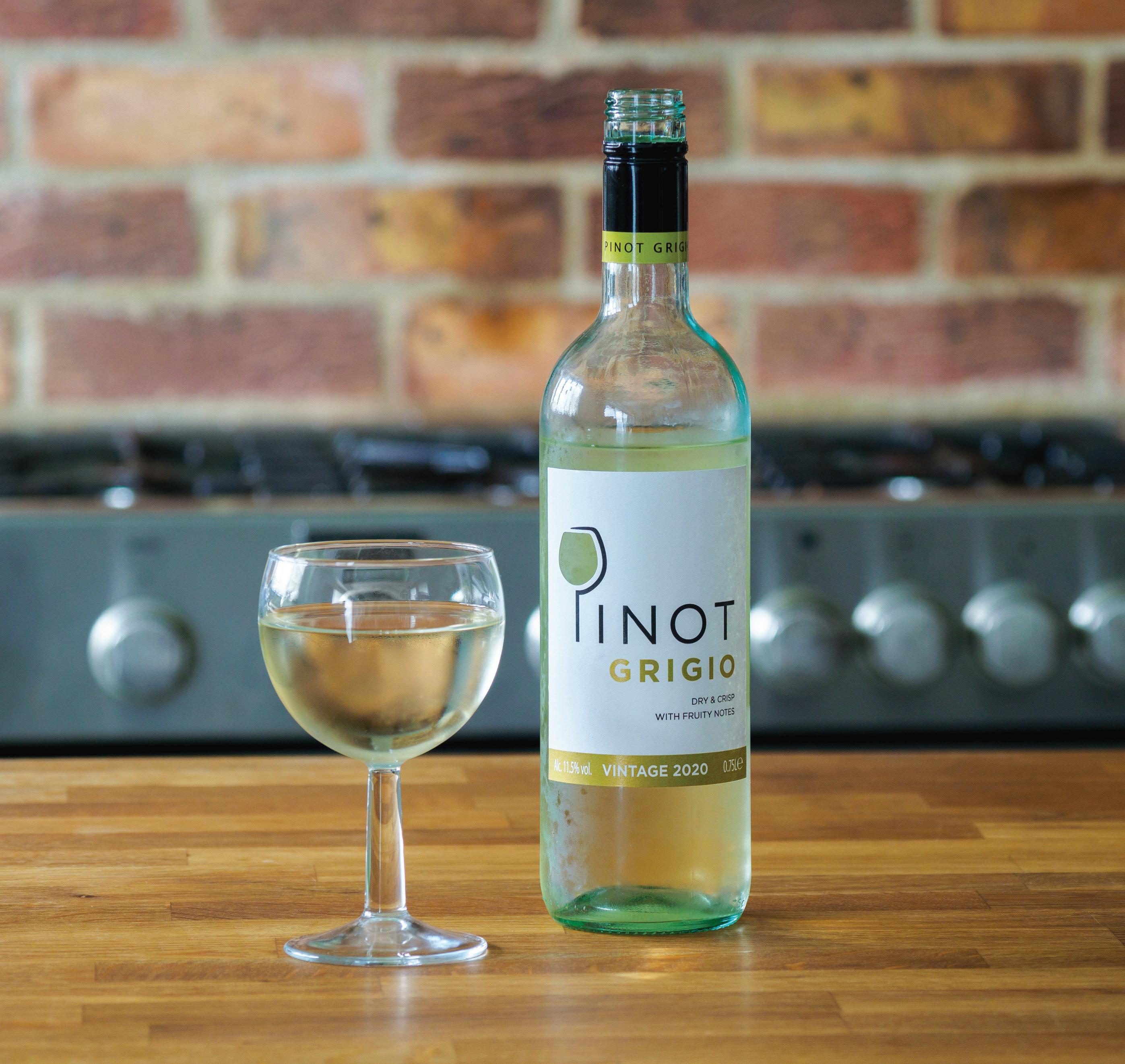
This backstory might help you wrap your head around ramato’s crazy col or: swirl it in just the right light and it glimmers like ripe watermelon pulp (ramato comes
from the Italian rame, meaning copper). Ramato’s flavors are equally distinct: zingy plums and wild green herbs (versus orange wine’s earthy, mushroomy flavors). If orange wine tastes like you’re jumping into a leaf pile, then ramato evokes the experience of plunging into the Mediterranean. Which brings me to my official endorsement: Ramato for president. Too much? OK, let’s go with the drink of the summer.
Producer spotlight:
Domestically, the producer to watch is Terah Bajjaliah, a natural winemaker based in Northern California’s Santa Clara Valley. Thanks to her impressively diverse training (a B.S. in finance, a master’s degree in enology and viticulture from France’s Montpellier SupAgro, a level-two sommelier certification) Terah’s approach is equally empirical and intuitive: She’s just as likely to conduct a trial as she is to listen to her heart.
Terah’s real superpower, though, is her feel for texture — evident across her lineup of skin-fermented whites, piquettes, and rosés. For Terah, skin fermentation is more than just a tool — it’s a way to push back on conventional notions of wine type and to find beauty between the lines. Her skill is on full display in her 2021 Terah Wine Co. Bassi Vineyard Ramato — blissfully earthy with flavors of dried apricots and miso dust. Terah sources her pinot grigio from a tiny organically farmed site in San Luis Obispo, just a mile or two from the coast. In the cellar, her approach is overtly old school — foot treading, native yeasts, aging in neutral oak barrels. The result is an expression of ramato that nods to the Friulian tradition, while establishing a style firmly rooted in the here and the now. And if Terah’s success is any indication, we’ll be talking about, and drinking, ramato for summers to come.
Find the Bassi Vineyard Ramato and other wines from Terha Wine Co at wineandpeace.com

in season 2023 29 You say ramato, I say summer DRINKS
If you’re nodding emphatically, then you, dear boomer, not only lived through pinot grigio’s golden age — you nudged it along. (Remember all those bottles of Santa Margherita piled up in the recycling?)
Between 1999 and 2000, pinot grigio sales rose by 40 percent.
On Martha’s Vineyard, crudo tastes just like summer.
Fluke Crudo
1 Tbsp. EVOO
2 tsp. toasted sesame oil
Zest one lime; use a zester, not a grater
3 tsp. fresh lime juice
2 tsp. tamari
1 tsp. unsweetened rice vinegar
2 Tbsp. red bell pepper, finely minced 1 jalapeno, very thinly sliced 2 scallions, thinly sliced on a bias
Fresh local fluke from the Island! Mix the first six ingredients to make the sauce.
Slice chilled fluke very thin on a bias, starting at the tail. Add to a chilled plate, distributing sauce around the fish; do not pour over the fish. Garnish with red bell and jalapeno peppers.

Try crudo this summer
Fresh local fish is the key ingredient for this dish.
WORDS + IMAGES Tina Miller
What is the difference between crudo and sashimi? Crudo means “raw” in Italian, and the fish is sliced very thin, and is often served with an olive oil and citrus base. Sashimi origins are Japanese, and the dish is usually made with raw seafood but can also be made with meat. Sashimi is classically served with a soy-based dipping sauce, and is often sliced razor-thin but can also be prepared in cubes
or other shapes. They are both interpretations of raw fish.
It is a world market when it comes to fish. Freshly shipped codfish, handled with care, comes from Iceland. Ocean-farmed salmon from the Faroe Islands is great for cooking. But nothing compares to local fish caught from the waters near the Island by members of our community. This time of year, you will often see fresh local fluke, also called summer flounder. Fluke is a flatfish and quite abundant around here. It’s sweet
and mild and perfect for a crudo. Other local fish worth trying are black sea bass, yellowfin tuna, sea scallops, bluefin tuna (not as common), and golden tilefish.
Ask your fishmonger which fish is Vineyard-local and which fish is the freshest.
Be sure you have the fish well chilled before slicing, and use an extremely sharp knife, cutting on a bias, starting at the tail-end of the fluke.
30 edible VINEYARD IN SEASON Try crudo this summer
and Food Family, Friends,
At the tip of Aquinnah, sitting just below the majestic Gay Head Lighthouse, is an up-Island destination that has only become more beloved over time, the Outermost Inn. In a genuinely provincial community with six towns, many of us are hunkered down in our neighborhoods and consider a drive to Aquinnah a true trek. Yet folks will drive to the far western end of the Island for beautiful food, strikingly dra-
matic surroundings where deer casually stroll by and ospreys fly above at the edge of where the ocean meets the land. Besides the beauty of the natural surroundings, the real reason guests keep coming back is the Taylor family tradition and hospitality they
find at the Outermost Inn.
Hugh and Jeanne Taylor built their home in Gay Head in 1971, and in 1998 the town officially changed its name to the original Wampanoag name, Aquinnah. By the mid-70s, the Taylors started a family, and their daughter Alexandra (Alex or A.T., named after Hugh’s older brother Alex Taylor) was born. Two and half years later, Isaac Taylor arrived.
“We used to rent the house in the summer to pay bills,” Hugh said. “By the late
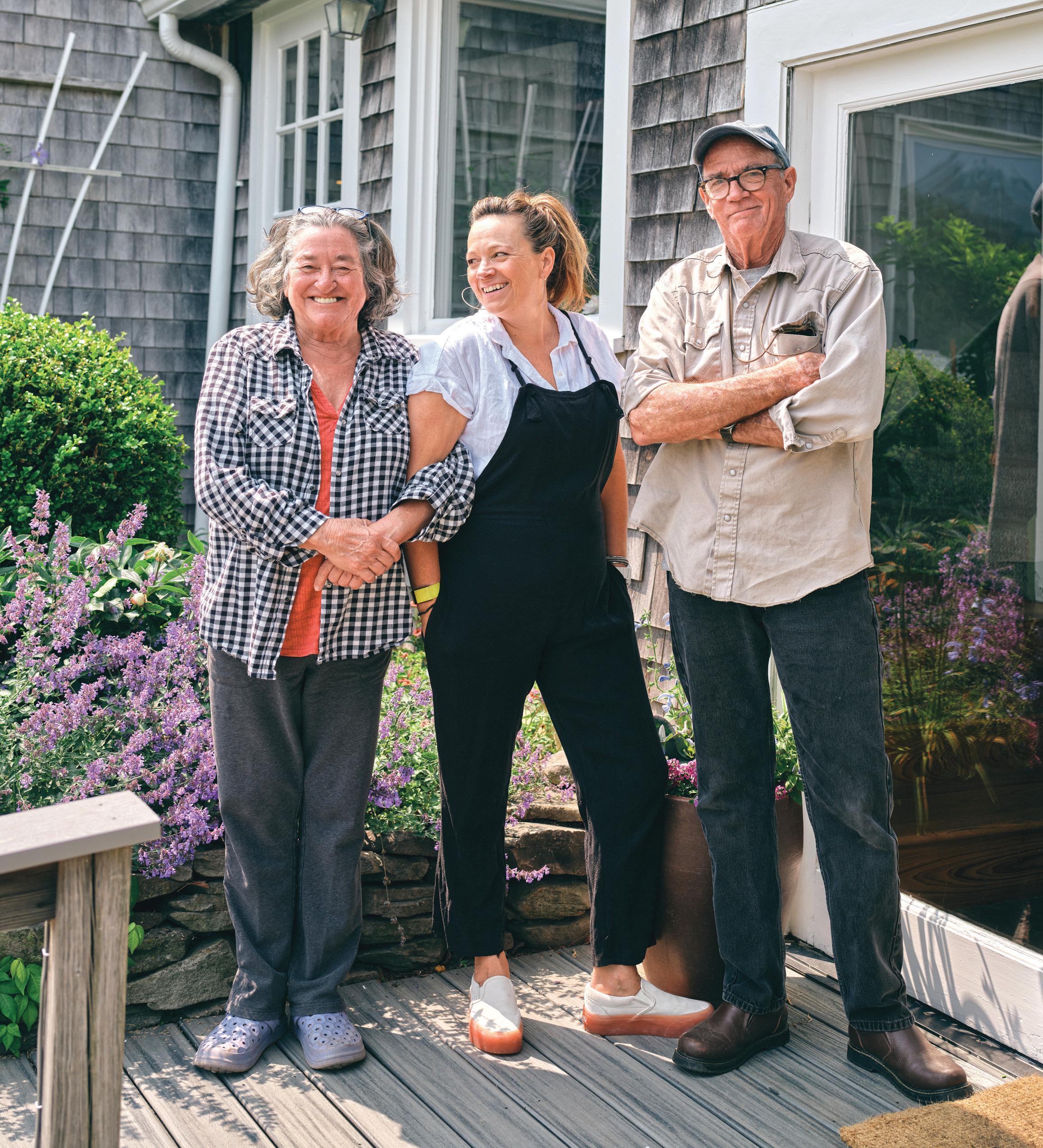
in season 2023 31 FEATURE
The Taylors have spent decades welcoming folks to the Outermost Inn.
WORDS
Tina Miller IMAGES Claire Callagy
1980s, the house needed repairs and upgrades, and so we decided to create the inn.” Hugh and Jeanne thought they also needed to diversify their income sources a bit.
“We went to the bank with a proposal and a prospectus to justify them lending us money to convert our home into a B&B, and they fell for it,” Hugh says. “We used that money to convert the house, adding seven guest rooms.”
Hugh figures it was around 1991 when they finally got the permit to open the
restaurant to the public. “It’s grown exponentially over the years,” Hugh adds.


Growing up in the family business, Alex and Isaac helped their parents run the seasonal inn and restaurant, doing everything from washing dishes to landscaping.

“As a teenager, I would work around the inn during the days, then I decided to try something different and started working at the Home Port at night. I did that for a few years,” Alex explains.
“With the inn and restaurant opened
to the public, it was busy. Eventually I transitioned from working at the Home Port to working here.”
Isaac had his own interests, though not far from home. He now lives across the street with his wife, Noli Taylor, and two teenage kids. Isaac and the kids are always around to help out.
As an adult, Alex also worked fulltime in administration at the Martha’s Vineyard Charter School. After twenty years at the Charter School, marriage,

32 edible VINEYARD
Zach Zelazny mixing it up.
Proud mom Alex, center, with daughters Violet, left, and Olive.
Hugh, Alex, and Jeanne Taylor are surrounded by years of memories.
and twin daughters Olive and Violet, it was time for a change.
“I was doing both, the Charter School and this, and in the end, I couldn’t do both 100 percent. Both jobs got 50 percent of my time, and both were suffering,” Alex says. “And so I either had to give up this or give up that. At that point, I wasn’t ready to give this up. They [Hugh and Jeanne] weren’t ready either. They certainly didn’t want to take on more responsibility if I transitioned out.”
Hugh explains how he felt about Alex
coming on full-time.
“We’re not restaurateurs,” he says, “basically, we’re entertainers, and Alex has come to the table with the knowledge totally in hand. So we wanted her in, but we really weren’t sure whether the place could afford it.”
Around this time, Covid hit, and like many in the restaurant and hospitality business, they had to pivot or perish. Hugh says he and Jeanne would always tweak things every few years to keep customers interested, and this became a time to re-invent once again. They needed to get creative with their business model, which had become exhausting for Hugh and Jeanne after so many years. “Jeannie and I were beginning to wilt a little bit from that, you know, the six months 24-hoursa-day,” Hugh says.
With the pandemic, renting rooms to the public was no longer feasible. Also, the housing crisis began to become critical. When it was time to reopen after Covid, the Taylors realized they were sitting on gold and could now house their kitchen staff and put all their focus on the restaurant.
Alex was running the front of the house, with energy, vision, and focus — with her feet firmly planted in the family business. A fresh breeze lifted the Outermost into a new era.
Covid caused a major shift, but it was a positive one for the business. Suddenly all of their outdoor seating became a major silver lining. This gave them a huge advantage, and a new set of diners were willing to take the dreamy scenic ride up the Island to the Outermost Inn, where they had plenty of parking, open space, and peaceful quiet. The restaurant hit its stride and became a sanctuary during the pandemic.
“We can open the place up to everybody. And so it gives them a feeling of what this Island is like, and what it has been like for all these years. We’re inviting people into our home,” Hugh says.
The food has always been exceptional, featuring a prix fixe, three-course menu for years with a menagerie of talented, chefs. They keep the family vibe going and cook up beautiful meals served on tables with flowers grown on the property. They have always hired locals and Island kids to work at the restaurant.

“As a guest at these tables, you see people you know or maybe a high school kid, and the guest asks, ‘Hey, do you live here?’ And the young Islander says, ‘Oh, yeah, I grew up down the road, and spend
my days fishing on the local waters off the Island,’” Alex explains. “It’s authentic and that’s important to us.”
Alex’s own daughters are no exception, now rising seniors in high school, you will find them working in the restaurant, keeping the family tradition alive.
This season, however, brings a new chef.
“We were blessed to have some incredible chefs here,” Alex says. “I mean, I don’t know how we tripped over all the great chefs over the years.”
This year was the first year the family conducted a professional search for a chef. Their last chef, Scott Grilli, came to them during Covid, another streak of good luck out of the pandemic.
“Scott was incredible, and we all learned so much from him,” Alex says. But,
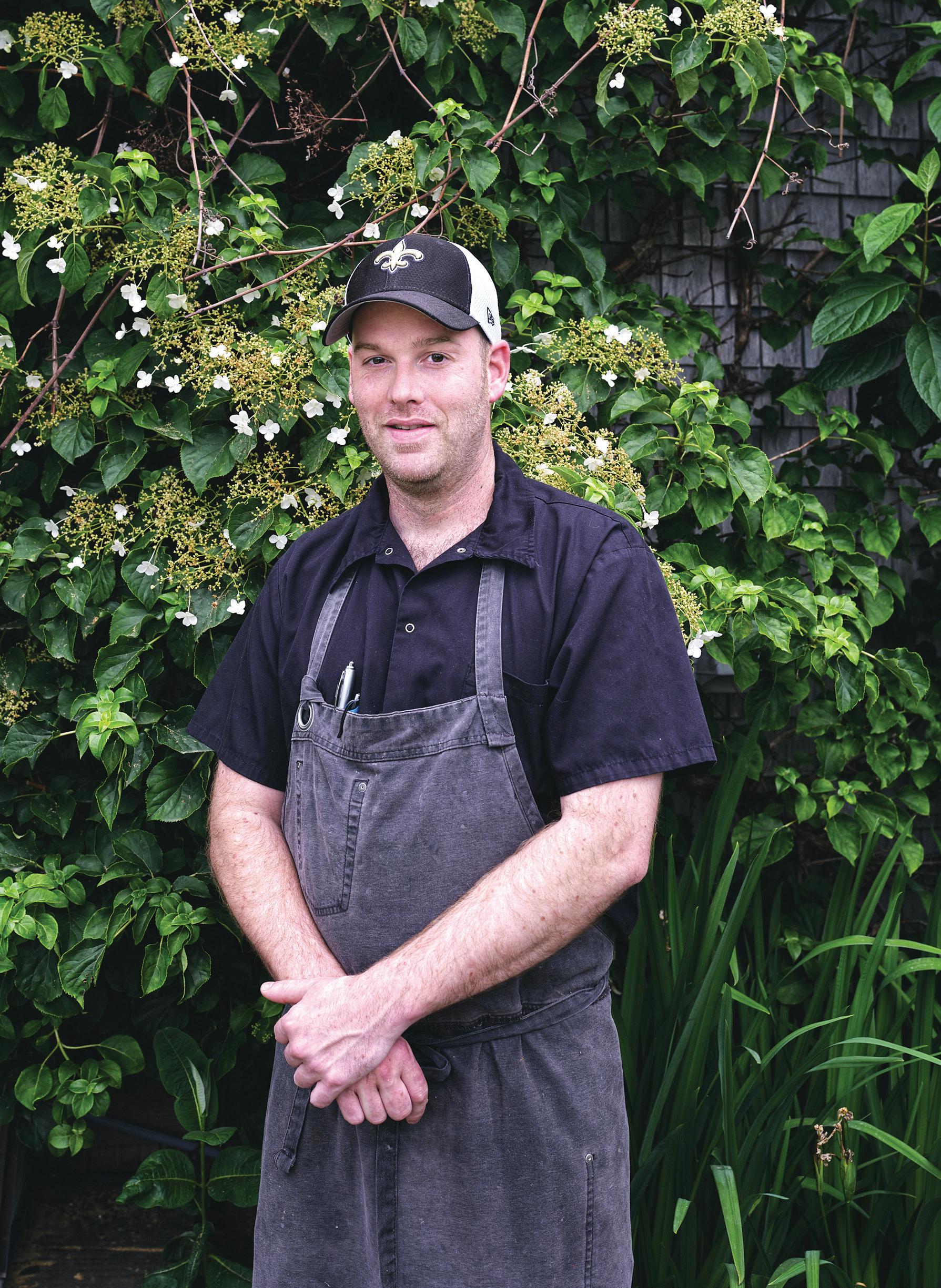
in season 2023 33
We went to the bank with a proposal and a prospectus to justify them lending us money to convert our home into a B&B, and they fell for it. We used that money to convert the house, adding seven guest rooms.
–Hugh Taylor
Chef Bryan Johnson
Family, friends, and food FEATURE
Beautiful, serene views at Outermost Inn.
FEATURE Family, friends, and food
as life happens, Grilli is also in the middle of a sailing adventure around the world, and he needs to be free to keep going and not just sail in the winter.
After months of searching and 25 resumes, the Taylor family found Chef Bryan Johnson, who lived and worked in New Orleans. Johnson worked in restaurants including N7, Le Chat Noir, and Sofia. The Taylors traveled to New Orleans, a food paradise, last winter and Chef Bryan and his team cooked a beautiful meal for the Taylors.



“The experience was incredible,” Alex says. “They were incredibly well organized. I mean they really pulled it together for us in a way that was very, very impressive.”
The new chef was not only concerned about packing up and moving to the remote western end of Martha’s Vineyard, but also about pulling together a kitchen team and how to get supplies to the restaurant. In the end, Chef Bryan brought his team from New Orleans, including a master oyster shucker, for a seamless transition.

As for sourcing supplies, most people who eat locally assume restaurants have plenty to choose from, but most Island farmers are smaller scale and prefer not to wholesale everything they grow. The farmers need to keep their own farm stands stocked and
are also committed to the Farmers Market, so it is difficult to fill an entire menu with local food. Ironically, the most difficult item to get in Aquinnah is fresh fish. It seems no one wants to deliver past Chilmark center. In the past, the crew at Outermost Inn have had great luck with the Fisherman’s Collaborative, an extension of the Martha’s Vineyard Fishermen’s Preservation Trust out of Menemsha. Still, the Outermost makes it work to include as many locally grown ingredients as possible, from oysters, clams, and lobster to fresh salad greens and veg-
etables. Johnson and his team came to the Island a month early to learn the lay of the land — and sea — and to learn the intricacies of doing business on an Island.
Every year is a new season on the Vineyard; it’s an opportunity for businesses to reboot, retool, and refresh. This is something the Taylor family has done well over the past 33 years, welcoming the public to their home and business. The family vibe, authenticity, quality, and familiar Island faces, is the secret sauce to the longevity of this family jewel.
34 edible VINEYARD
We were blessed to have some incredible chefs here. I mean, I don’t know how we tripped over all the great chefs over the years.
–Alex Taylor
Beautiful menu offerings from Chef Bryan.
Pesto with a past
Editor’s note: I worked at the West Tisbury library — more than a few years ago now — and I’ve wanted this pesto recipe from then children’s librarian Nelia Decker ever since. Nelia not only won the hearts of parents and children during her many years at the library, but she also won over our taste buds with her bright-green pesto made from the basil growing in the little garden at the library. We asked Nelia for the backstory of her delicious pesto.
MaryAnn Dolezsar from the Martha's Vineyard Garden Club approached me about making a kids’ garden on the library grounds in the spring of 2016. We had been in the new library for two years and we were excited about trying something new for kids outside to go along with the lovely landscaping that was in place. We decided to have a pizza garden, the goal being a pizza party at the end of the summer. Sounds great, right? Fast forward, I was out most of the summer with knee surgery, deer decimated the garden (they didn't much like the basil, but loved the tomatoes) and that left the library staff carefully and heroically watering the garden, dragging giant hoses back and forth every day. So, making lemonade out of lemons, and grabbing all the glory, I ad libbed and decided to have a pesto party in September. We made it with the kids, outside on the deck. We spread it on crackers — not wanting to involve boiling water for pasta. Most of the kids had never tasted it, and all of them really liked it. The novelty of eating at the library, eating something we had grown and then made ourselves cinched the deal. Now, of course, the library offers all kinds of snacks and food for families... which is wonderful.
This recipe is from the original Moosewood Cookbook published in 1977. I first visited the Moosewood restaurant in Ithaca, N.Y. I had never eaten pesto before and found it to be a revelation. I was at-
that if you blanche the pesto leaves before adding them to the food processor, the color of the pesto stays green, instead of turning a rather less attractive, but still delicious, brownish-green. Pesto freezes well; try using an ice cube tray for smaller portions. I make it at home all the time, in September, with basil I have grown. I put it on everything. One of my favorite ways is with potatoes. Boil new potatoes; when cooked, drain and slightly mash them adding butter, salt, and pesto. Yum.
Pesto

About six servings of pasta or gnocchi
3 cups packed fresh basil leaves (removed from stems)
2 large fresh garlic cloves
½ cup pine nuts, walnuts, almonds, or a combination
¾ cup (packed) fresh parsley, chopped
¾ cup fresh grated parmesan
½ cup olive oil
¼ cup melted butter
Salt to taste
Combine everything in a food processor on low, then medium speed. (Arrange things so the blender blade will turn efficiently.) Then work everything into a smooth paste. Toss with hot, drained pasta or spoon onto hot gnocchi.
in season 2023 35
Nelia Decker shares her recipe for the potent paste that tastes great on nearly everything.
FROM THE KITCHEN
WORDS Neila Decker ILLUSTRATION Allison Roberts
FEATURE A ‘good pierogi’ story
Continued from page 21
helped with events and sold pierogi on the side. The Island was not exactly what I expected. It’s beautiful and the beaches are great, but it was quickly clear it was more than that. That July and August I was not only busy, I made true and deep connections. While there is no tradition of Polish food, the highly seasonal way I grew up eating and cooking myself, fit-in here. It might seem odd to say, but I think my home shares a sensibility with the cooking traditions on this Island. There is an appreciation of the simple dishes of working people, made with freshly gathered products.
Last summer I returned, working as the chef at Fantzye. Over the winter I made my pierogi, sold them at farmers’ markets and cooked dinners, offering food from my Polish point of view, in Tucson (I’ve found a new home there). This year I’ll be back, cooking dinner and snacks at Dock Street Diner in Edgartown every Tuesday starting July 11, serving my favorite dishes made with local ingredients from menus that will change weekly. Expect my hand-cut local beef (or lamb) tartar, pickled fish, and, of course, you will always find pierogi.
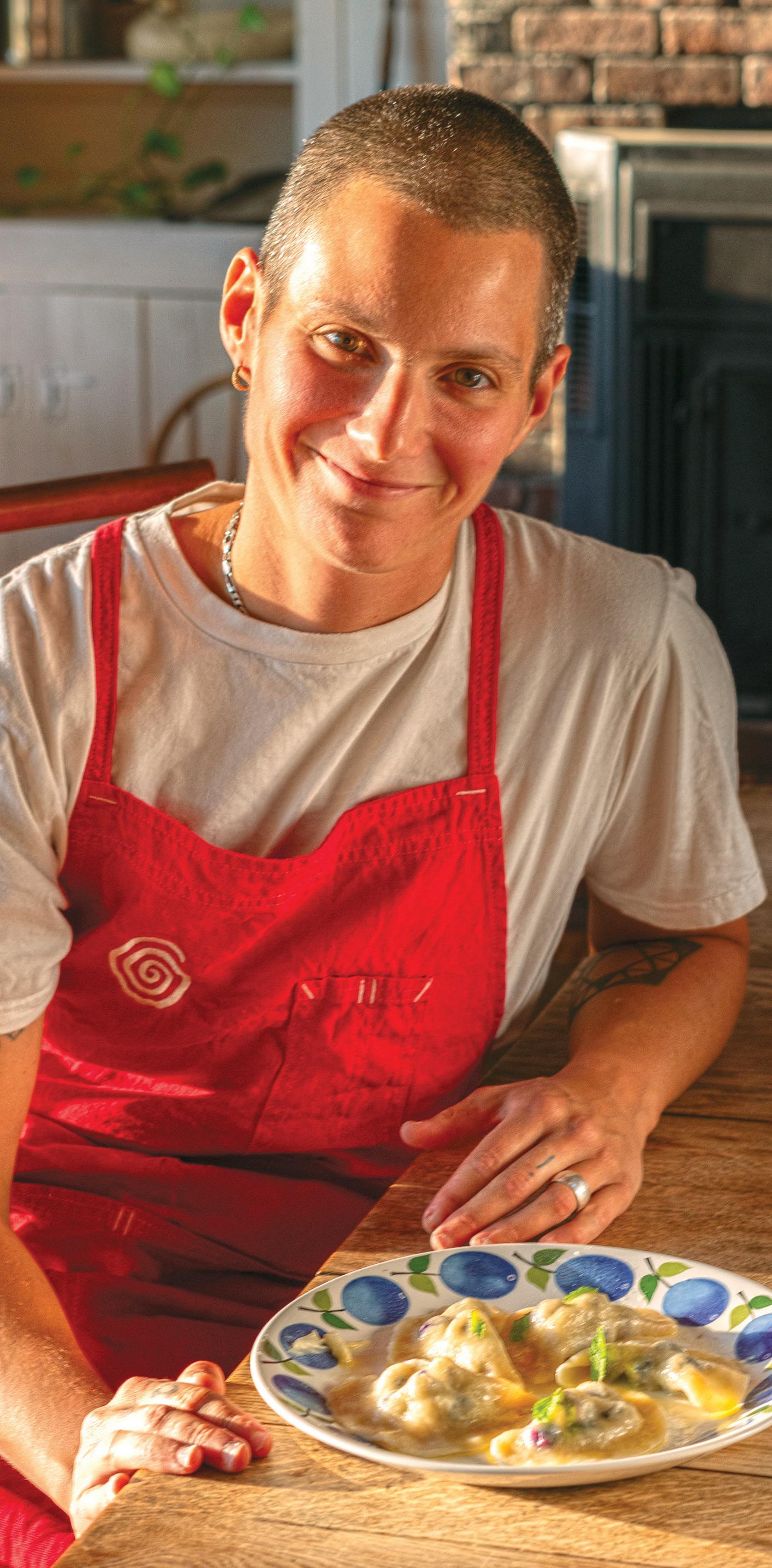
Pierogi Dough
Makes enough for about 30 pierogi
Delicate is the best way to describe the dough, which is the secret to Krem’s ethereal pierogi. To get this result, avoid flour with too much protein and be careful not to handle the dough more than necessary or you will activate the gluten. When available, Krem prefers to use locally grown and milled flour, but otherwise finds King Arthur all-purpose works well.
¾ cup plus 1 ½ Tbsp. water
*1 Tbsp. kosher salt
2 Tbsp. plus ½ tsp. neutral oil such as canola (or melted butter)
400 to 450 grams (2 ½ to 3 cups) high quality all-purpose flour
Heat the water so it is too hot to hold your finger in for more than a second. Put the water in a bowl and mix in the salt then the oil (or melted butter). Stir in 2 ½ cups of the flour, mixing until combined. Turn
36 edible VINEYARD
Chef Krem with finished pierogis.
the dough out onto a clean surface and knead just enough so the dough can be formed into a smooth ball, adding more flour if it is sticky. (Be warned, the dough may still be hot when you begin to work it.)
Form the dough into a ball and cover it with a clean kitchen towel and set it aside to rest for at least 15 minutes (or wrap it in plastic and refrigerate for up to 3 days or freeze it for at least 3 months — bring the dough to room temperature before proceeding).
*If you use Morton kosher salt, use 1 ½ tsp., it is ground differently than Diamond Crystal.
Paprika-Braised Lamb Pierogi
Makes about 30
You can use ground lamb (easy to find) or mutton (more flavorful and available from local farms) for this filling. Either way, Krem recommends using three types of high quality paprika: sweet, smoked, and Hungarian — which has a rich taste with both sweet and smoky notes. The goal is interplay between the flavors of the different dried peppers. You can omit the Hungarian paprika if it proves hard to find, then use 1 ½ Tbsp. of sweet and 2 tsp. smoked.
2 Tbsp. neutral oil, such as canola
1 pound ground lamb (or mutton)
*1 Tbsp. kosher salt
1 medium onion, peeled and diced
2 cloves garlic, peeled and minced
1 Tbsp. Hungarian paprika
1 Tbsp. sweet paprika
1 ½ tsp. smoked paprika
1 Tbsp. freshly ground black pepper
1 bay leaf
1 quart stock — beef, chicken, or vegetable stock (water will also suffice)
1 recipe pierogi dough
Melted butter seasoned with vinegar or sour cream for serving
Chopped parsley for serving
Heat the oil in a large skillet or a Dutch oven over medium high heat. Add the lamb and salt. Brown the lamb, breaking up the
clumps of meat with a wooden spoon as you go, and turning it over in the pan so it colors evenly, about 15 minutes. Using a slotted spoon, transfer the cooked lamb to a bowl. Reduce the heat to medium and add the onions and garlic to the fat in the pan. Cook, stirring frequently, until the onions are soft and golden, about 10 minutes. Add the paprikas, black pepper, and bay leaf, mix well and let fry until the mixture is fragrant, 2 minutes or so, then add the stock and lamb. Bring the liquid to a boil, then reduce the heat to low and simmer the filling, partially covered, stirring occasionally, and adding a little water if the meat looks dry. Cook the filling until the lamb is fully tender, the flavors blend and the liquid has reduced and formed a nicely thick gravy, about 2 hours. Taste and adjust the seasoning with salt if necessary. Chill the filling (it can be refrigerated for up to 3 days).
Roll out the pierogi dough on a lightly
baking sheet; Reserve in a warm place and repeat, cooking the remaining dumplings. Serve the pierogi warm, topped with melted butter seasoned with vinegar then garnished with chopped parsley; or serve pierogi with sour cream. (Note: for fried pierogi, boil the dumplings as described then brown them in a skillet in clarified butter or a mix of oil and butter.)
Perfect Blueberry Pierogi
Makes about 30
Krem doesn’t add sugar to the blueberries in this, the ultimate summertime pierogi filling, relying instead on the natural sweetness of berries. Serve the pierogi topped with sour cream or browned butter. Either way finish with a sprinkle of sugar: crystalized, brown or granulated. If you have access to black currants, they make a sensational alternative.
About 1 ½ pints blueberries
1 recipe pierogi dough
Browned butter or sour cream for serving Sugar for serving Pick through the blueberries.
floured surface (or use a pasta machine). You want it less than ¼-inch thick (leave it a little thicker if you plan to freeze your dumplings — see box). Using a 3¼-inch cutter or a standard-sized glass, cut the dough into about 30 rounds. If you like a thin wrapper (and are not freezing your pierogi) roll each round out just a touch more. Spoon a little filling in the center of each round, then, working one at a time, fold the dough around the filling, then carefully and firmly press the edges together, making sure the edges are no thicker than the rest of the wrapper. Immediately before serving, bring a large pot of salted water to a boil. Working in batches (to avoid crowding the pot) drop pierogi into the water. Simmer the dumplings until the dough is cooked through, the filling heated and they float, about 3 minutes. Transfer the pierogi to an oiled
Roll out the pierogi dough on a lightly floured surface (or use a pasta machine). You want it less than ¼-inch thick (leave it a little thicker if you plan to freeze your dumplings — see box). Using a 3¼-inch cutter or a standard-sized glass, cut the dough into about 30 rounds. If you like a thin wrapper (and are not freezing your pierogi) roll each round out just a touch more. Place berries in the center of each round, then, working one at a time, fold the dough over the berries, then carefully and firmly press the edges together, making sure the edges are no thicker than the rest of the wrapper.
Immediately before serving, bring a large pot of water to a boil. Working in batches (to avoid crowding the pot), drop pierogi into the water and simmer until the dough is cooked, the berries soft and the pierogi float, about 3 minutes. Using a slotted spoon, transfer the cooked dumplings to an oiled baking sheet; Reserve them in a warm place and repeat, cooking the remaining dumplings.
Serve the pierogi topped with browned butter or sour cream and your choice of crystalized, brown or white sugar.

in season 2023 37 A ‘good pierogi’ story FEATURE
Pierogi topped with brown butter.
Predators or partners?
Since the first carcass washed up on an Island beach nearly 20 years ago, Islanders have been worrying, speculating, and, of course, arguing about what the presence of coyotes would mean for Martha’s Vineyard. We haven’t faced an apex predator here since Chief Brody and Quint’s fateful victory over Jaws, and we’re understandably wary of the arrival of a new species.
On the one hand, coyotes could help some imbalances in our ecosystem — their diet consists mainly of small mammals, like rats and rabbits, as well as the young of larger animals, like turkeys and deer. All of these are plentiful on the Island, and in some areas considered nuisances. Surely a natural predator would be preferable to human interventions — poisoning rats is dangerous and often deadly to birds of prey who ingest them. But just as other species thrive here a little too well for our liking, so could coyotes. We’ve all heard stories and read news reports from the mainland of coyotes attacking pets and decimating livestock — a particular problem for an Island with a strong agricultural presence.

Tisbury Animal Control Officer Heather Maciel shares the concern of the farming community, and she predicts the Island will look a lot different if the population explodes as it has in other areas in Massachusetts.
“People aren’t going to be able to free-range their chickens anymore,” she speculates, “and they’re going to need to rethink lambing season altogether.” Island farmers are a practical group. They are used to protecting their land and animals from all sorts of dangers — disease, drought, hungry wildlife with Olympic-level jumping and digging abilities. And when faced with a new threat, they are quick to
reach out for help from those with more experience.
This past winter, Heather invited Dan Proulx, a problem animal control agent from Swampscott, Mass., to speak to Islanders about the interaction between coyotes and humans. In addition to tips on keeping pets and livestock safe, Dan encouraged Islanders to work together to come up with a plan that works for our unique community. Since then, a group of Is landers has been meeting — representatives from the hunting and farming communities, as well as naturalists and law enforcement officers. Heather has been coordinating
these meetings and is impressed by their success in gathering information. Hunters, who are typically very secretive about their hunting spots, are sharing footage from trail cameras they have all over the Island. Island naturalist Gus Ben David has identified at least six different individuals, and numerous dens, in photos and videos from Aquinnah to Edgartown. Not a huge number, but coyotes are aloof creatures, and there are surely more who are evading notice.
This group continues to meet to ex change information and is in the process of developing methods of sharing what they learn. The coyotes are currently doing what
38 edible VINEYARD
ON THE FARM
WORDS Kate Athearn IMAGE Karen Blackerby Logan
Sure, there are jokes about packages from the Acme corporation appearing and hiring a team of roadrunners to help out.
Wily or not, we may have to learn how to coexist with coyotes.
we want them to do- keeping to themselves. There have been very few reports of domestic animals being disturbed. For now, the most sensible course of action is to encourage them to keep their distance. There are things farmers and landowners can do themselves, like securing fences and changing feeding practices. But if their neighbors are leaving their trash cans unfastened, or worse — actively feeding them, coyotes will learn to associate humans with food, and consequently teach their young to do the same. On the other hand, if we “haze” coyotes — make lots of noise, wave our arms, throw things in their general direction — whenever they approach us or our land, they are more likely to remain afraid of us. If they continue to pass that particular survival skill on to subsequent generations, we’ll have a much easier time coexisting with them as their numbers grow.
Group members are confident that Islanders can work together to prevent a major problem. We have had the luxury of watching coyotes spread across the state and can benefit from seeing what hasn’t worked in other areas. Sure, there are jokes about packages from the Acme corporation appearing and hiring a team of roadrunners to help out. But for the most part, Islanders are taking the threat seriously. We are prone to heated discussions about sports fields and school renovation projects, but we unite around so much more. We value our access to open spaces, lush forests, and local eggs and lamb. We take pride in supporting one another and jump at the chance to band together in the face of adversity. Even our less desirable traits may be the most helpful in fighting this particular fight with this canine species. Our long and complicated relationship with visitors has left us with a healthy suspicion of off-Islanders. Despite our ability to be polite, even welcoming, to tourists who stop by for a quick visit, those who try to establish themselves here have a tougher time. And if those “washashores” think they can barge in and hijack our closely guarded Island traditions, well, we have a way of making them feel most unwelcome.


in season 2023 39
Predators
or partners? ON THE FARM







40 edible VINEYARD Subscribe to the MV Times for just $45 per year. That gets you online access and our daily email newsletter produced by The Times. The Minute will arrive in your mail inbox every weekday around 4 pm, with a roundup of the day’s news, photos, events, specials, and everything MV! By subscribing to The Times, you’ll support local journalism and your favorite Island. Go to mvtimes.com/faqs for more information. We’ve got the Vineyard covered... Minute by minute
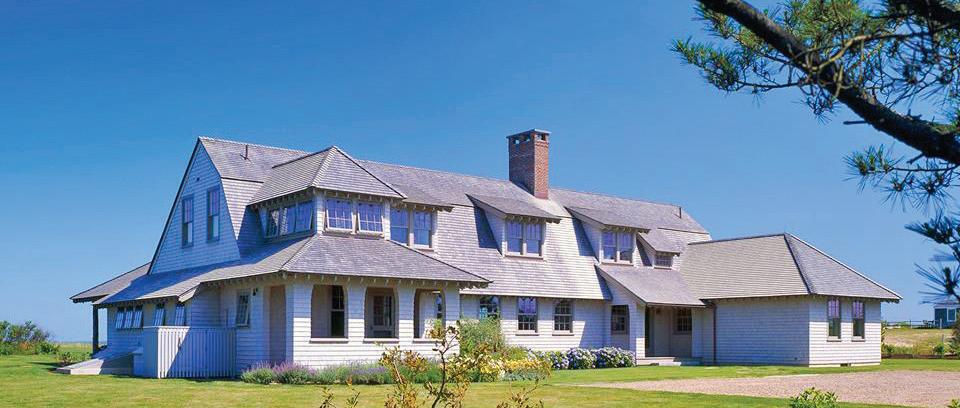







in season 2023 41 Doyle Construction Corp. Quality Home Building on Martha’s Vineyard 54 Hidden Village Road, West Tisbury, MA 02575 www.doyleconstructionmv.com • 508.693.9004 • bmazza@doyleconstructionmv.com Experts in construction, renovations and restoration of high quality homes on Martha’s Vineyard since 1990. CHEESE B EEF PORK PANTRY EGGS RAW MILK BREAD PASTRY FARMSTAND OPEN 8 A M - 6 P M — CLOSED TUES D A Y –THEGR E YBARNANDFARM. C OM FARM T OURS IN Q U I RE ABOUT F A R M • GAR D EN CREAMER Y • BAKE R Y
Continued from page 23
taste sweet for the pollinator bees they are meant to attract. Still others are spicy or reminiscent of the herb or plant itself, like arugula or kale flowers. It’s helpful to taste each variety and get to know the flavors yourself — you may not want to use a garlicky chive blossom on a dessert or a pungent white cilantro flower in your iced tea. And invite your guests to sample and enjoy the edible flowers; people don’t often know they can.
When you pick flowers, check for any insects feeding inside the flower, but avoid rinsing or soaking. Most are too delicate for this step. If not using immediately, keep chilled in the fridge until ready to use.
Edible bouquets
If you can’t grow or forage for flowers, a great way to experiment this summer is to sample the edible bouquets available for sale at North Tisbury Farm Market on State Road in West Tisbury. Owner Rose Willett says the sampler bouquets sell for $10 and might include zinnias, a variety of cosmos that’s edible, sweet alyssum, Johnny jump-ups, bachelor buttons, nas turtiums, and other edible flowers as they bloom in the garden out back.
“It’s something I’ve been trying to get people interested in for a number of years; I’d put them out and nothing would happen,” says Willett, who started using flowers along with herbs more than a decade ago to decorate cheese and charcuterie platters. “I just didn’t give up and last year it really took off, which was great.” A Johnny jump-up or borage flow er, for example, she says looks beautiful on a triple cream cheese. Willett says the market plans to dry flowers this year and create blends to sell, as well as making compound butters, salt mixes, and cakes decorated with flowers. Willett says the dried flowers keep their colors and look great on desserts as well as savory dishes like halibut or sole.
Kitchen uses
If you are having a party, do what I did as a caterer and head to the garden to pick a bowlful of green herbs and edible flowers to have on hand. They always get used and every dish looks a little more artistic. In my own kitchen, even though there’s a garden out back, I like
Quinoa Salad with Peaches and Flowers
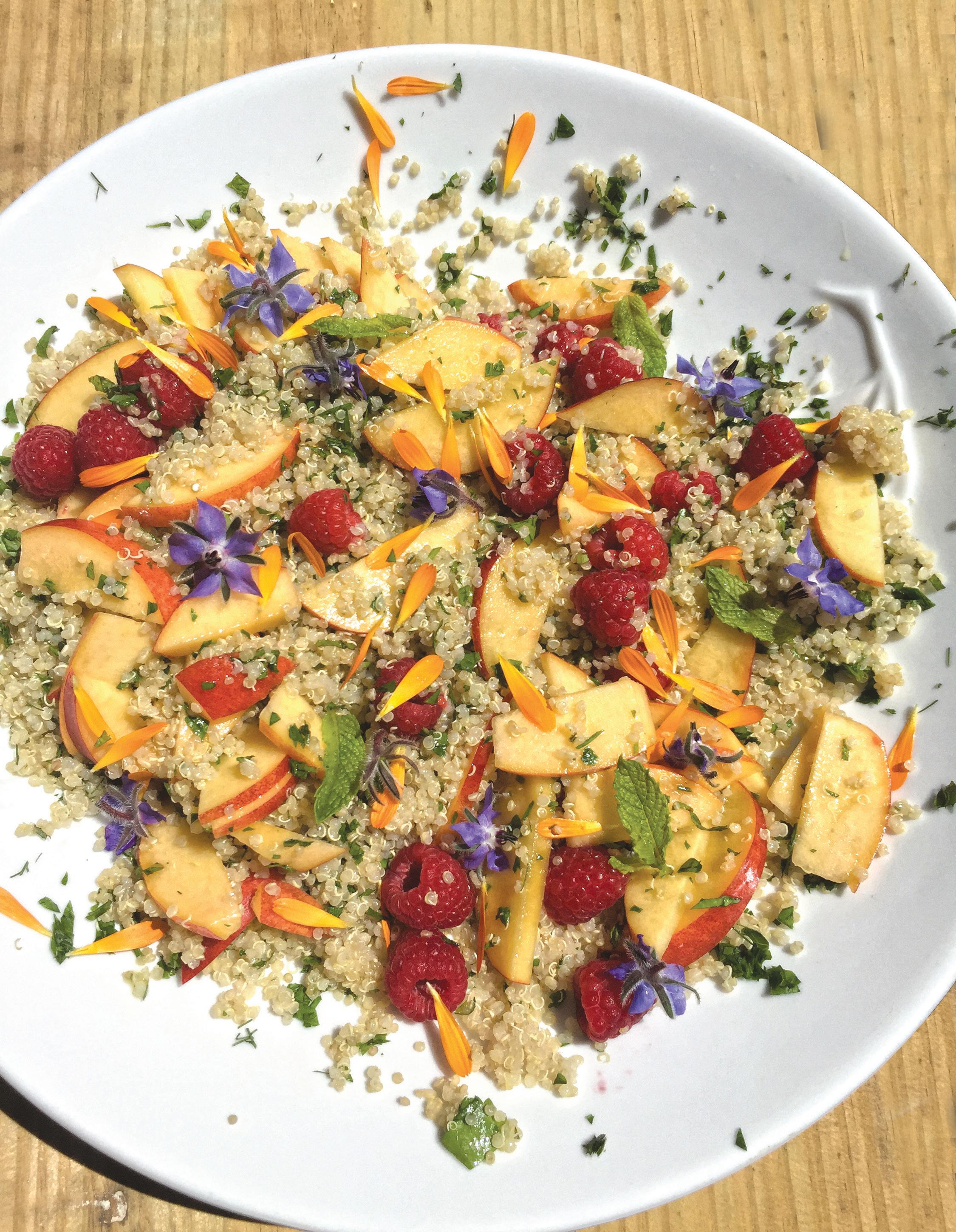
Serves 8 as a side
This colorful salad is a good side for the summer table with everything or for a brunch. The key to cooking quinoa just right for salads (not mushy) is to use less than 2 cups of water for every 1 cup of quinoa. I usually aim for 1 2/3 cups of water. Chopped mint is also a nice addition, along with the parsley.
1 cup quinoa
1 cups water
Salt
1 cucumber, peeled, quartered lengthwise and cut into thin triangles
1/2 cup microgreens, baby kale, or finely chopped parsley
1 cup raspberries, rinsed and dried (or substitute blueberries or halved cherries)
2 peaches, peeled and sliced (or nectarines, which don’t need peeling)
Edible flower petals for garnish (calendula petals and borage are shown above)
Dressing
2 Tbsp. lemon juice
3 Tbsp. fresh orange juice
2 tsp. raw honey or maple syrup
2 tsp. minced shallot
3 Tbsp. olive oil
2 good pinches of salt
Add quinoa, 1/4 tsp. salt and 1 2/3 cup water to a saucepan. Bring to a boil and then reduce heat to low, cover, and cook for 12-13 minutes, until the water is absorbed. Turn off the heat and let the quinoa sit for 5 minutes. Remove the cover and set aside to cool completely.
Combine the cooled quinoa with cucumber and greens.
Make the dressing in a small bowl by whisking together the lemon juice, orange juice, olive oil, honey or maple syrup, shallot, and salt. When ready to serve, add to the quinoa and vegetables and toss gently to combine.
If you dress only what you are eating that day, the salad will keep nicely for a few days.
Gently fold in the peaches and raspberries. Garnish with edible flowers.
42 edible VINEYARD FEATURE Pretty Plates
ine W a l t h e r s
Cather
Quinoa and peach salad with edible flowers.
to fill two or three tiny vases with various bouquets of herbs and flowers, and put them on the counter. They not only look and smell great, but it keeps me from running out to the garden constantly and allows me to experiment daily. Recently, I was adding flowering thyme sprigs to drinks and using the abundant winter savory in every dish I could, trying to figure out where it tastes best.
My favorite use for flowers seems to be summer drinks like iced tea and lemonade — and any and all cocktails. Mixing and matching flowers and herbs together such as sprigs of thyme and flowering anise hyssop — really any green and any flower — always looks appealing. You can also make ice cubes for summer drinks by mixing different flower petals and herbs and when


frozen, popping them into ziplock bags ready for use. Pretty much any and all salads look better with a few flowers or flower petals.


Adding flowers to enhance desserts, the finale, is a natural. Top cupcakes with a beautiful edible flower, or mix in with any dessert featuring berries and whipped cream, like shortcakes or pavlova.


in season 2023 43 Pretty Plates FEATURE
Make any drink colorful with edible flower ice cubes. Cather in e W a l t h sre Call 508-693-6100 press # 35 or email adsales@mvtimes.com. Scan to read online anytime at ediblevineyard.com Missadvertising inthisissue? Advertise in the Harvest issue publishing October 5.
Continued from page 27
two native goldenrods, sunflowers, purple and white clover, butterfly weed, and two species of monarda. Of course, variety matters. Sunflowers with double blossoms are of little interest. Single medium sunflowers were a hit,” Matt laughs.
Emily Armstrong, the education director of Island Grown Initiative and participating partner in the project, explains the project in another way.
“The biggest shift for me as a farmer is to think about who I am growing food for. While growing food for humans on these farms, can we also create a space to feed the insects and birds?” Emily loves the pollinator plot at IGI. “It is so beautiful to arrive at the farm and have this area that is blooming and buzzing all summer.”
Matt explains that a basic piece of wild bee biology is that bees are “pollen specialists.” “For example, Colletes validus love blueberry pollen, feeding mostly on blueberry flowers. It has an elongated face so that it can reach into the flower,” Matt says,

showing us a photo of a pale yellow bee sticking its nose into a blueberry blossom.
“The ecology of bees is fascinating and can be closely tied to human ecology,” Matt continues. “For instance, the squash bee, Peponapis pruinosa, feeds almost exclusively on squash flowers. It apparently started out feeding on native squash species in the Southwest. As those plants were selectively bred and cultivated across more of North America, the bee went with them, and it's now feeding on pumpkin flowers on Martha's Vineyard.
“We also knew that honeybees are socially dominant, but I soon learned that they are highly motivated fascists,” Matt says laughing, “and they are highly selective. They want one nectar, one pollen resource. They will suck a patch dry, snarfing up all the good stuff.” Looking ahead, one of the things Matt is thinking about is “Offering something for everyone. A mix of resources. Something for the honeybees and something for other bees so everyone has food and is happy.”
Fair warning, when Matt gets going on the bees, you will be exposed to a hive
(sorry, just one bee joke) of incredible photos — “check out the legs on this one,” “look at the eyes here” — and to his passion for the subject. Fortunately, there is a way for all of us to track and learn what he and the farms have found. This is where the Martha’s Vineyard Atlas of Life comes in.
MVAL uses the INaturalist platform to help Matt, and anyone else observing life in the pollinator plots, to upload and catalog their findings. “INaturalist is a joint initiative between the California Academy of Sciences and National Geographic Society,” Luanne tells us. “We use it for a variety of projects. It’s incredible. It harnesses artificial intelligence combined with really strong naturalists who are identifying and contributing to the app to identify species. The more that is contributed to the app, the more the app learns. Sure, anyone could take a pic of a flower or butterfly and could use Google Search and get a visual ID, but the photo might be mislabeled on Google. With INaturalist, what you get is more accurate. What is even cooler about it is that it is global. You see flowering patterns,
FEATURE Bees’ Needs
44 edible VINEYARD
Bembix Americana, or sand wasp, on goldenrod.
pinch points for road kill. I use it every day.”
“Experts are reviewing the photographs as well,” Matt adds. “So if the artificial intelligence botches the identification, it will be corrected. Essentially, it is like crowdsourcing for nature.” To become an INaturalist contributor, you just need a smartphone. After that it is pretty easy. You take a picture of the subject and upload it. “There are varying degrees of data quality,” Matt says. “Two people then must agree on the identity of the subject,” which, according to Matt, makes the data “research grade.”
One of the many cool features of the INaturalist app is that the data can be visualized. In other words, you can select for the MV Pollinator Pathways Project plots and get a map of what has been spotted and identified on each farm in the last year.
When reflecting on the first year with the MV Pollinator Pathways Project, Matt says, “We were pleasantly surprised by the sheer number of bee species found in the pollinator plots. We identified about 35 spe-
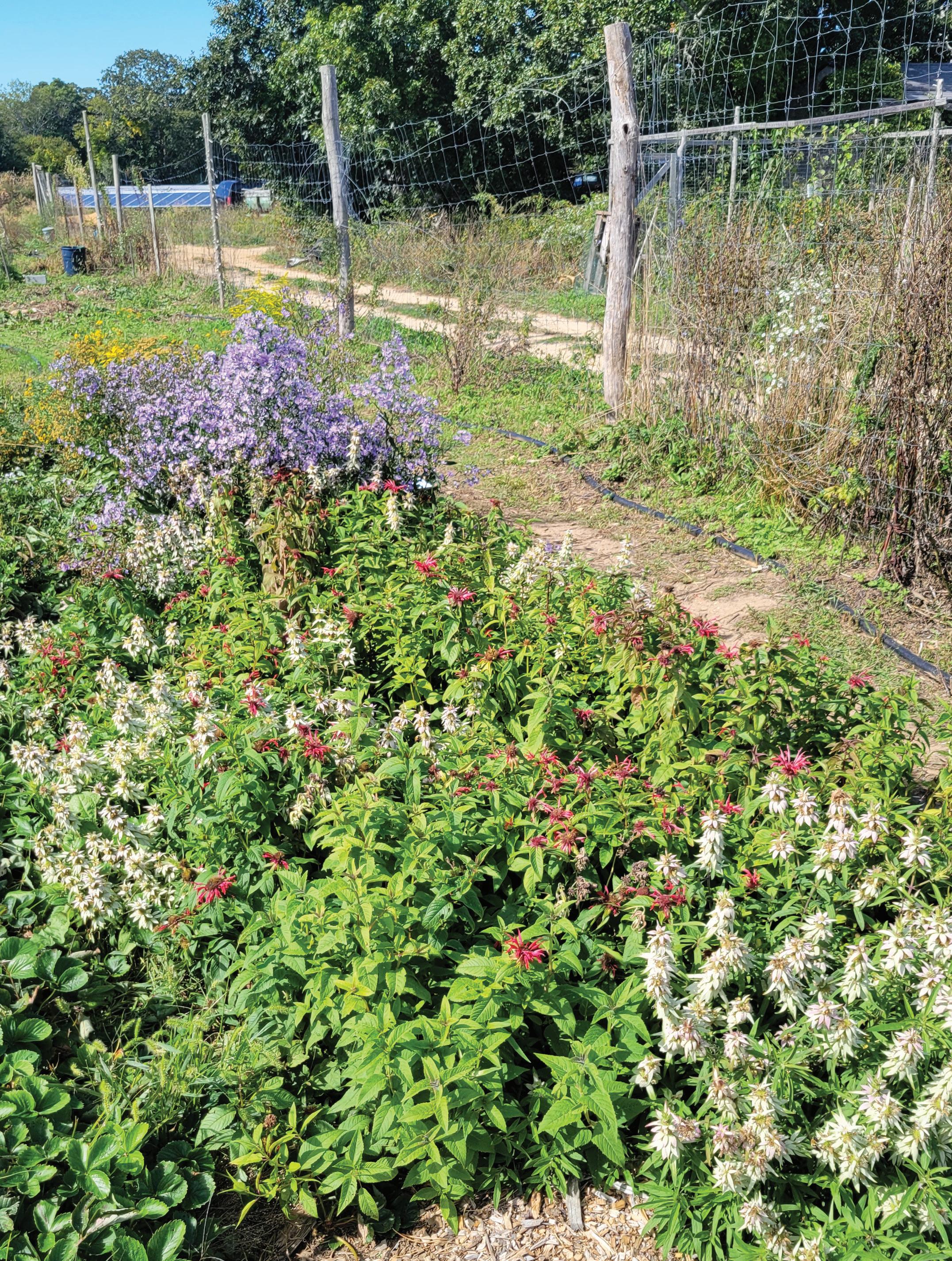


cies. There are roughly 192 species on the Island, and we have added another half dozen species so far this year. Some we missed — in any given year you miss certain things. I’m sure we will find new ones next year.”
In the first year, “some farms produced more observations than other farms,” Matt says, “Habitat accounted for a lot of this. The pollinator plot at the Farm Institute was in the middle of a field, whereas Mermaid Farm’s area was closer to woodlands and a wetland. Because Mermaid Farm’s land was more inherently diverse, we saw a greater diversity of bees.”
Betsy expands on this thought, “Matt shared insights about how the diversity of surrounding habitat is connected to the success, or lack thereof, of our project plots on the farms. Regardless of our efforts to attract various species of pollinators through our plantings, if the plots exist in a place where there is already little in the way of bee habitat or food nearby, it doesn’t matter how many plants we have there to attract them; it is difficult for them to find the plot and they are not going to thrive. This underscores the importance of planning for biodiversity across a landscape. I look forward to seeing how the richness of the data being collected improves as our plantings mature in the project plots. With this rich data we hope that farms, homeowners, and municipalities see the benefit of the types of plantings we have done to expand the network of pollinators across the Island.”
“I was surprised by the bee fauna at each farm. The distribution of bees was complex,” Matt says. “Each farm had such a distinctive mix of bee species. We found an abundance of metallic sweat bees at North Tabor, but none at Beetlebung, which is just a short distance away. In the next year, I am interested in thinking more about landscape context and a bee’s ecological requirements. For example metallic sweat bees nest in rotted wood. North Tabor has an unmanaged woodland nearby, whereas Beetlebung does not. Is this nesting availability why we see more metallic sweat bees at North Tabor Farm and not at Beetlebung? I want to analyze things as much as I can. Why this set of species here and not that set of species there? I love this stuff. It’s really just what I want to do all the time.”
in season 2023 45 Bees’ Needs FEATURE
Megacyllene robiniae is more commonly known as the locust borer.
Whippoorwill Farm is part of the pollinator project.
OUR
















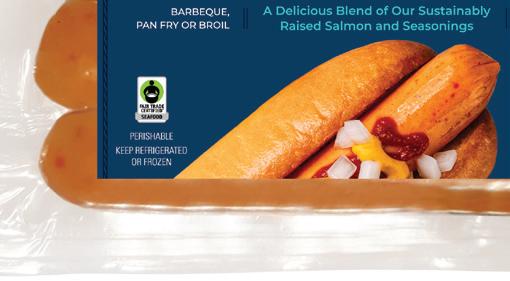




Find Kvarøy’s salmon hot dogs in the frozen section of the fish and seafood department at Whole Foods Market. Find a store near you
SALMON HOT DOGS ARE DELICIOUS, HEALTHY,
SUSTAINABLE IN EVERY BITE! Proud supporter of Can a
AND
HOT DOG CHANGE the World?

DONE!
A whale of a fish tale
The recreational fishing season is in full swing off Vineyard waters. There are plenty of posts on Instagram of the Islanders hauling in beloved striped bass, perfect for grilling, sauteing, and broiling.
In an effort to preserve the striped bass stock, we have seen changes in the regulation size for the keepers.
In May of this year, the Massachusetts Division of Marine Fisheries enacted emergency recreational regulations, creating a sweet spot in the size of bass that can be kept. The new maximum length limit for keeping striped bass in Massachusett is now 28 inches to less than 31 inches, and anglers will still be permitted to keep one fish per day.
Decades ago before these regulations,
there were photos and stories of landing the “big one.”
We asked well-known angler and landscape painter Kib Bramhall to tell us his best “Fish Tale” from the past.
“My most memorable fish was the 42 lb., 14 oz. striped bass that I caught on the final morning of the Derby in 1981, about a mile west of Cape Poge Light on Chappy. I had started fishing at 5 pm the previous afternoon and — with sporadic naps on my buggy — had fished all night. Several small bass and blues had been caught early, but by 3 am, everyone had left but me. The bass hit about 30 feet from shore at 5:15 and took 20 minutes or so to land. In addition to winning, the catch broke the world record for the 12-pound leader.”

48 edible VINEYARD
DONE
Photo Mark Lovewell/Courtesy Kib Bramhall
Artist and fisherman Kib Bramhall tells us about the one that didn’t get away.


 Vineyard Haven 508-693-4457 • West Tisbury 508-693-2234
Vineyard Haven 508-693-7097
Vineyard Haven 508-693-4457 • West Tisbury 508-693-2234
Vineyard Haven 508-693-7097
Office (508) 362-1309



Mobile (508) 364-3917
jwdarchinc@icloud.com
josephwdick.com
JWD Edible July AD 6-30 FIX.pdf 1 6/30/23 4:58 PM




















 By Maddy Alley
By Maddy Alley

































































































































 Vineyard Haven 508-693-4457 • West Tisbury 508-693-2234
Vineyard Haven 508-693-7097
Vineyard Haven 508-693-4457 • West Tisbury 508-693-2234
Vineyard Haven 508-693-7097


